Homes with southeast-facing gardens are considered a luxury in many places since they receive the best lighting throughout the day.
As sunlight is essential for us human beings, it is also quite crucial for several stunning plants that can liven up your garden.
While there are several plants that like warm conditions and strong sunlight, there are also many that don’t.
This is why I have compiled a list of plants that are optimal for a southeast-facing garden that is warm and sunny.
30 Plants for Southeast Facing Garden
- Surfinias
- Million Bells
- Iris
- Roses
- Chrysanthemum
- Marvel-of-Peru
- Egyptian Star Cluster
- Sun Dance
- Lavender
- Borage
- Chives
- Bay Laurel
- Black Bamboo
- Silver Spear
- Windmill Palm
- Angelica Gigas
- Purple Coneflower
- Johnson’s Blue Geranium
- Argentinian Vervain
- Chamomile
- Japanese Banana
- Chinese Wisteria
- Foxtail Lily
- Crocosmia Lucifer
- Allium
- Himalayan Lily
- Winter Daphne
- Christmas Box
- Gertrude Jekyll Rose
- West Himalayan Birch
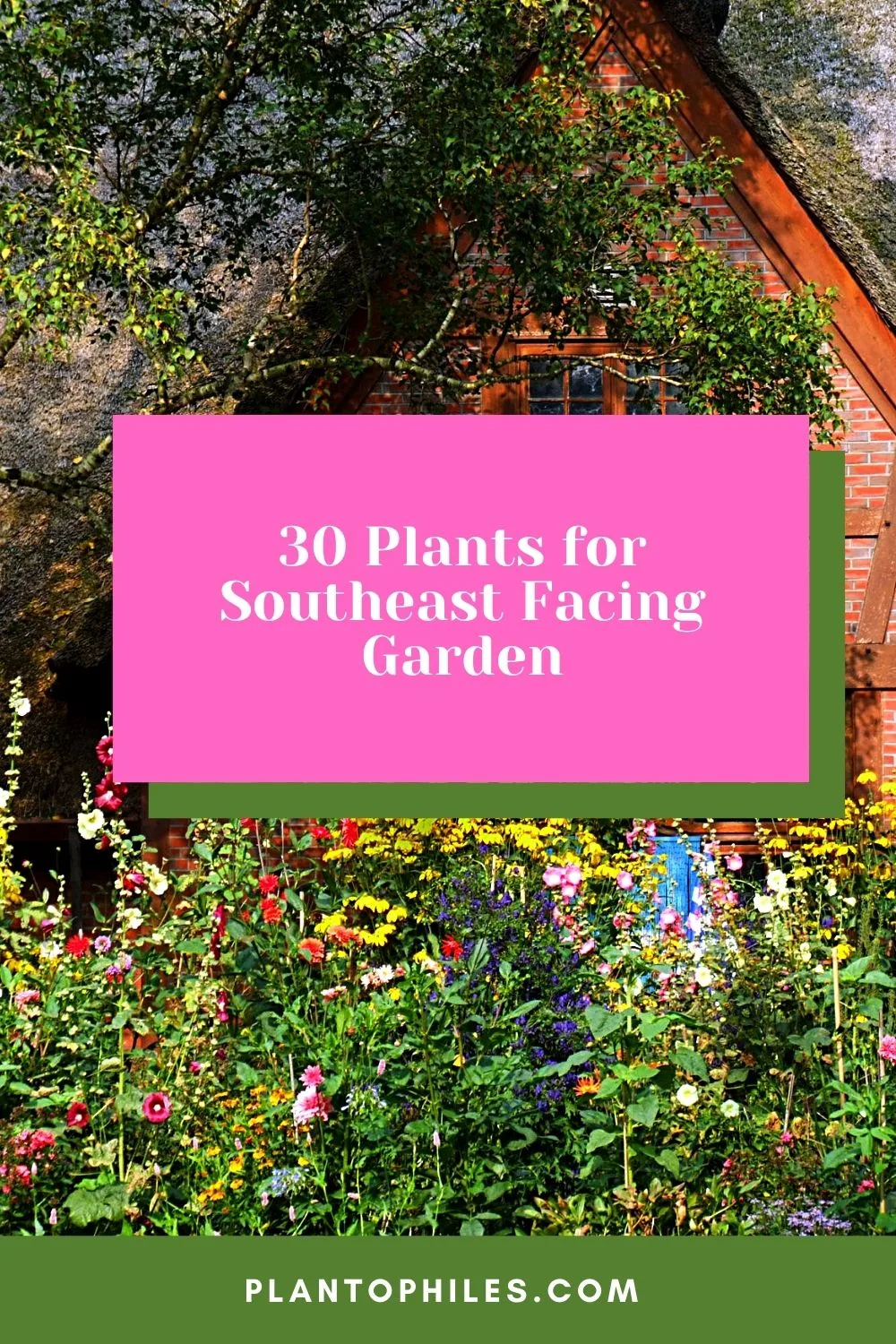
30 Plants for Southeast Facing Garden
Table of Contents
30 Plants for Southeast Facing Garden
1. Surfinias
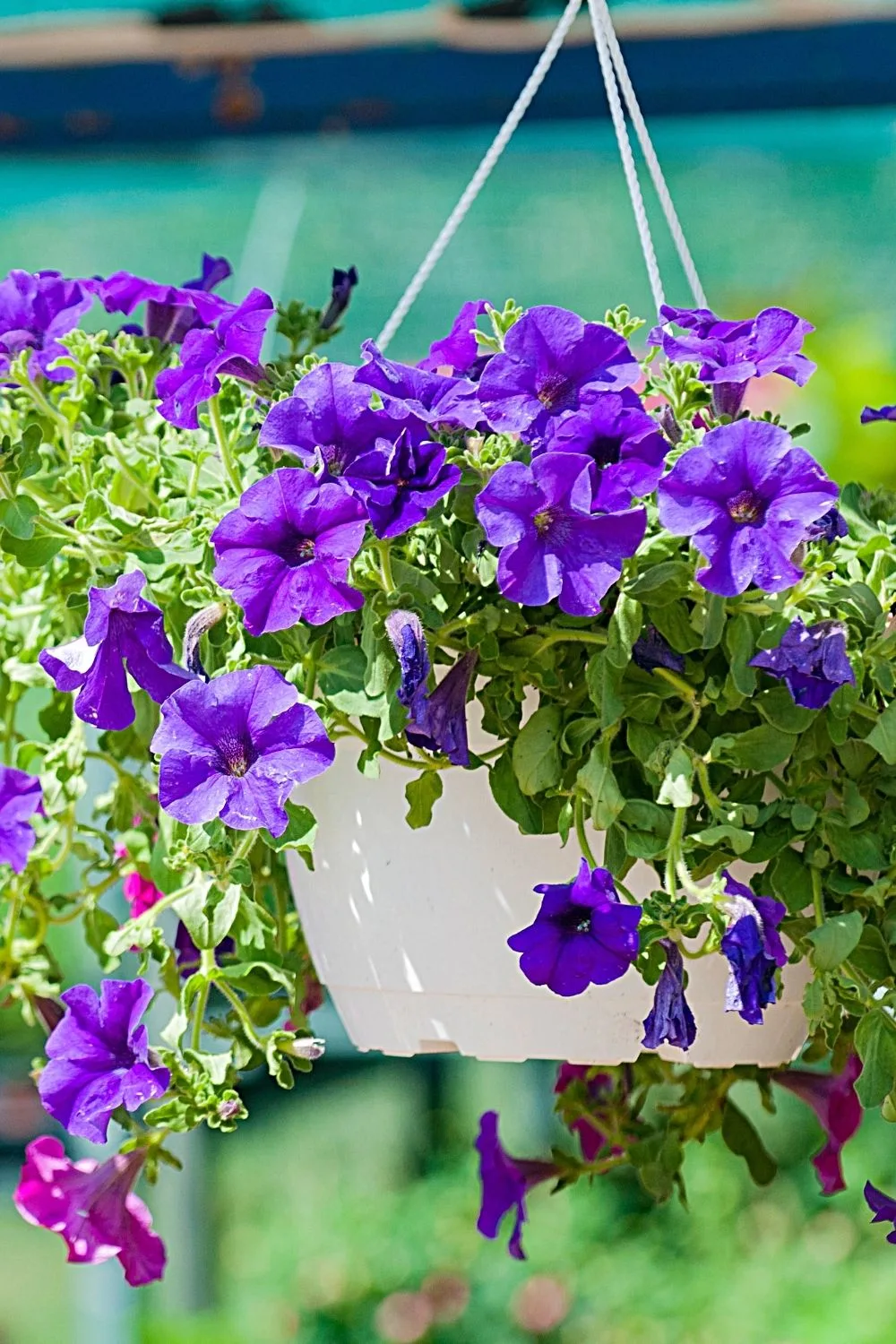
Surfinias grow bell-shaped flowers that help beautify your southeast-facing garden
Surfinias are similar to Petunias in terms of the flowers they grow.
This plant also grows bell-shaped flowers that come in various colors, such as:
- Purple
- Red
- Pink
- Violet
- Yellow
- White
- Orange
The flowers can also grow in a mixture of colors such as pink and white or purple and white.
Surfinias binomial nomenclature and basic plant care requirements include:
- Temperature: around 55 to 65 degrees Fahrenheit (13-to-16-degree Celsius)
- pH: 0 to 7.0
- Soil: Needs moist, but well-drained soil
- Fertilizer: Needs high nitrogen fertilizer
- Lighting: full sunshine, but can also tolerate partial shade
- Growth rate: fast growth
- Humidity: 40% to 60%
- Scientific name: Petunia × atkinsiana Surfinia Group
- Family: Nightshades
2. Million Bells
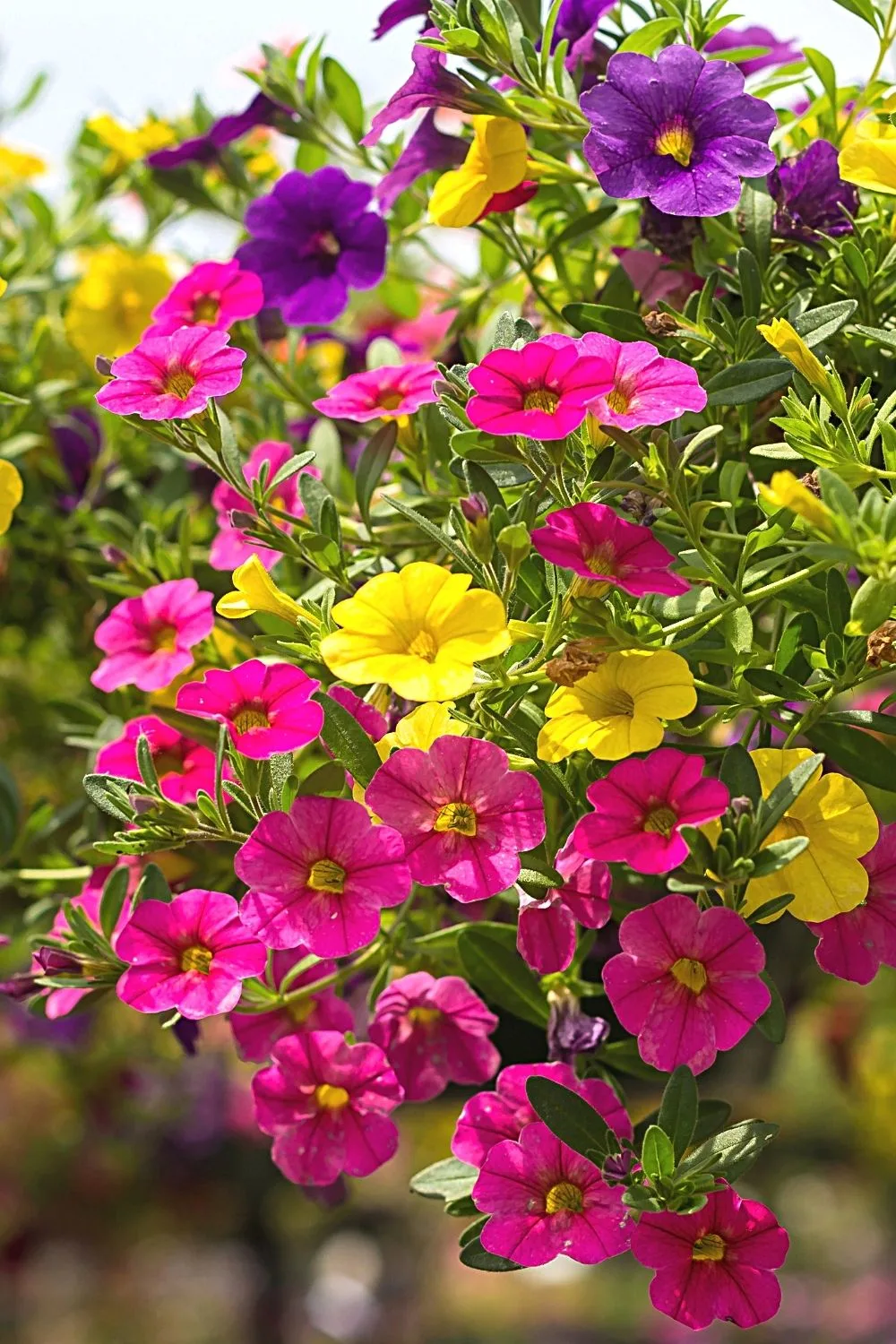
Million Bells, with its famous colorful flowers and foliage, are a great addition to your southeast-facing garden
Million Bells is famous for its colorful flowers and foliage. You will find its foliage in colors ranging from blue/green to gold/chartreuse.
Million Bells have a trailing habit and require full sun according to the University of Michigan.
While the flowers on Million Bells can be found in colors ranging from blue to red.
Million Bells binomial nomenclature and basic plant care requirements include:
- Temperature: Prefers 55 to 65 degrees Fahrenheit (13-to-16-degree Celsius)
- pH: 5.0–6.5
- Soil: Needs moist, rich, and well-drained soil
- Fertilizer: needs slow-release fertilizer every other week to promote flower growth.
- Lighting: requires full sunshine
- Growth rate: fast growth
- Humidity: 40% to 60%
- Scientific name: Calibrachoa
- Family: Solanaceae
3. Iris
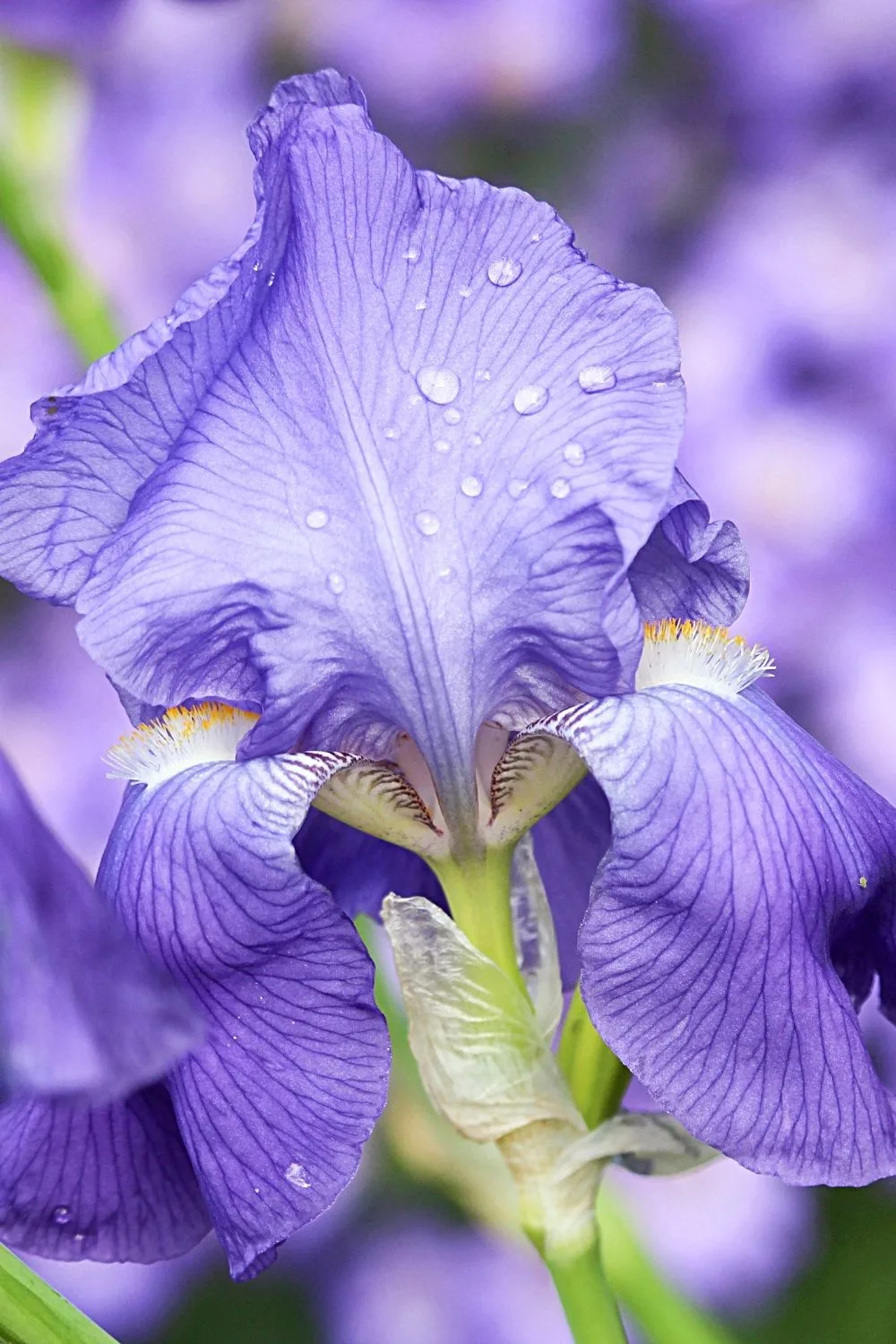
Iris, named after the Greek goddess, has a stunning color that’s another great addition to your southeast-facing garden
Iris is a tall and beautiful plant that is named after a Greek goddess. This stunning plant can be found in a variety of colors since there are 300 species under the Iris genus.
The most common Irises are the bearded, tall ones that grow up to 3 feet in height.
Irises binomial nomenclature and basic plant care requirements include:
- Temperature: Prefers 50 degrees Fahrenheit and above (10+ degrees Celsius)
- pH: 6.8 to 7.0
- Soil: Needs moist and Good drainage soil
- Fertilizer: Needs light, balanced fertilizer
- Lighting: bloom best in full sun
- Growth rate: fast growth
- Humidity: 60% to 75%
- Scientific name: Iris
- Family: Iridaceae
4. Roses
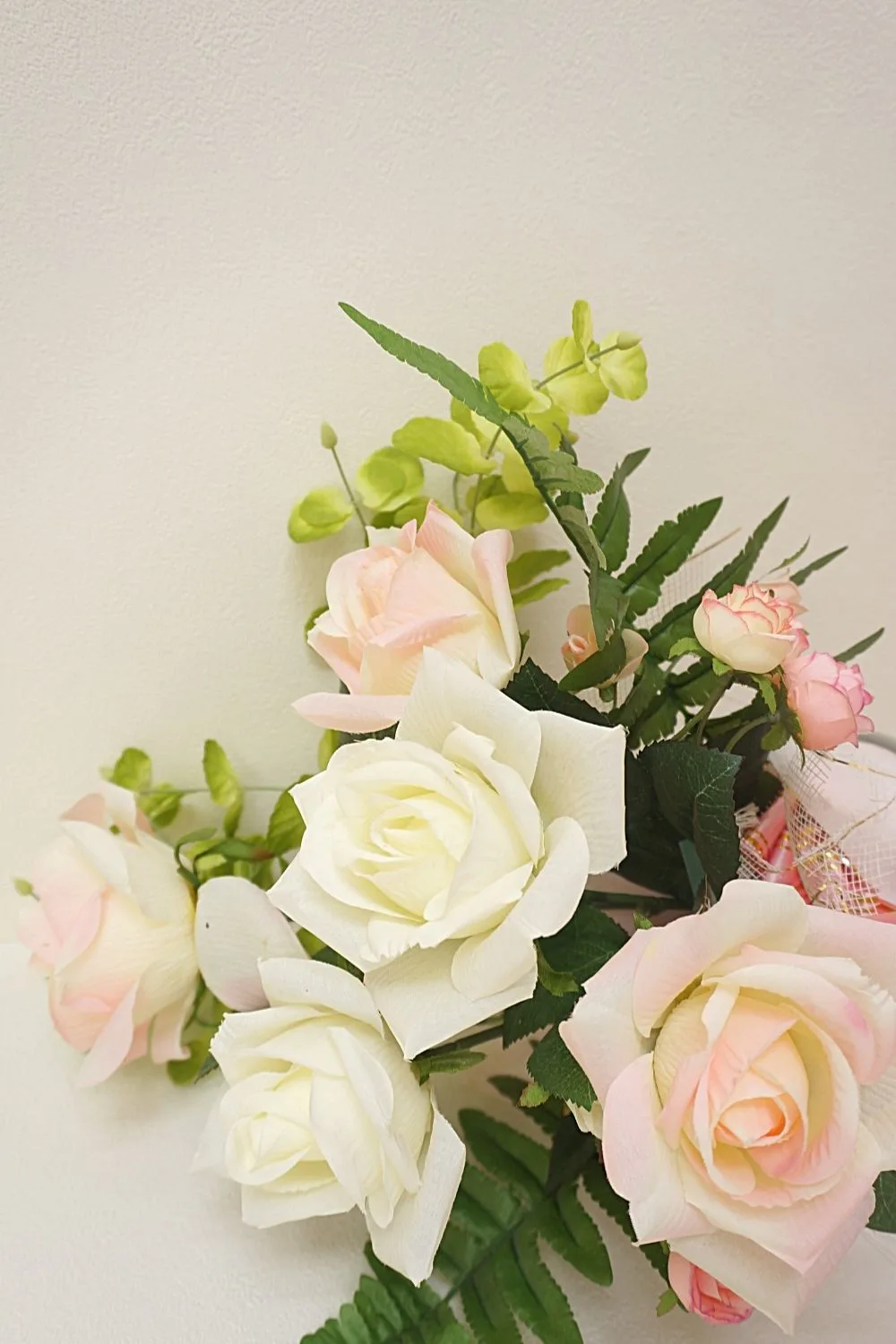
If you’re looking for flowers that you can easily give as gifts, then plant Roses in your southeast-facing garden
Roses are not an uncommon plant, and almost everyone has seen them at least once in their life.
They’re considered to be one of the most gorgeous blooms in the world often gifted to others on special occasions.
Since these flowers are so special and beautiful, a lot of people believe roses may be difficult to grow.
But this is not true because Roses are low maintenance plants that can grow in many different environments.
Roses binomial nomenclature and basic plant care requirements include:
- Temperature: Prefers 60 to 70 degrees Fahrenheit and above (16-to-21 degrees Celsius)
- pH: 6 to 6.5
- Soil: Needs rich moisture-retentive soil with good drainage
- Fertilizer: Needs slow-release fertilizer
- Lighting: six to eight hours of sunlight daily
- Growth rate: fast growth
- Humidity: 60% to 80%
- Scientific name: Rosa
- Family: Rosaceae
5. Chrysanthemum

Chrysanthemum, aka mums, is another beautiful plant to add to your southeast-facing garden
Chrysanthemums, also called mums, are flowering plants that have quite a unique appearance to them.
This beautiful plant grows large flowers that have several petals on them, which give the flowers a fuller look.
Chrysanthemum binomial nomenclature and basic plant care requirements include:
- Temperature: Prefers 60 to 85 degrees Fahrenheit and above (16-to-29 degrees Celsius)
- pH: 6.5 to 7.0
- Soil: Needs good drainage and moisture-retentive soil
- Fertilizer: Needs slow-release fertilizer
- Lighting: six hours of sunlight daily
- Growth rate: fast growth
- Humidity: 70% to 90%
- Scientific name: Chrysanthemum
- Family: Asteraceae
6. Marvel-of-Peru
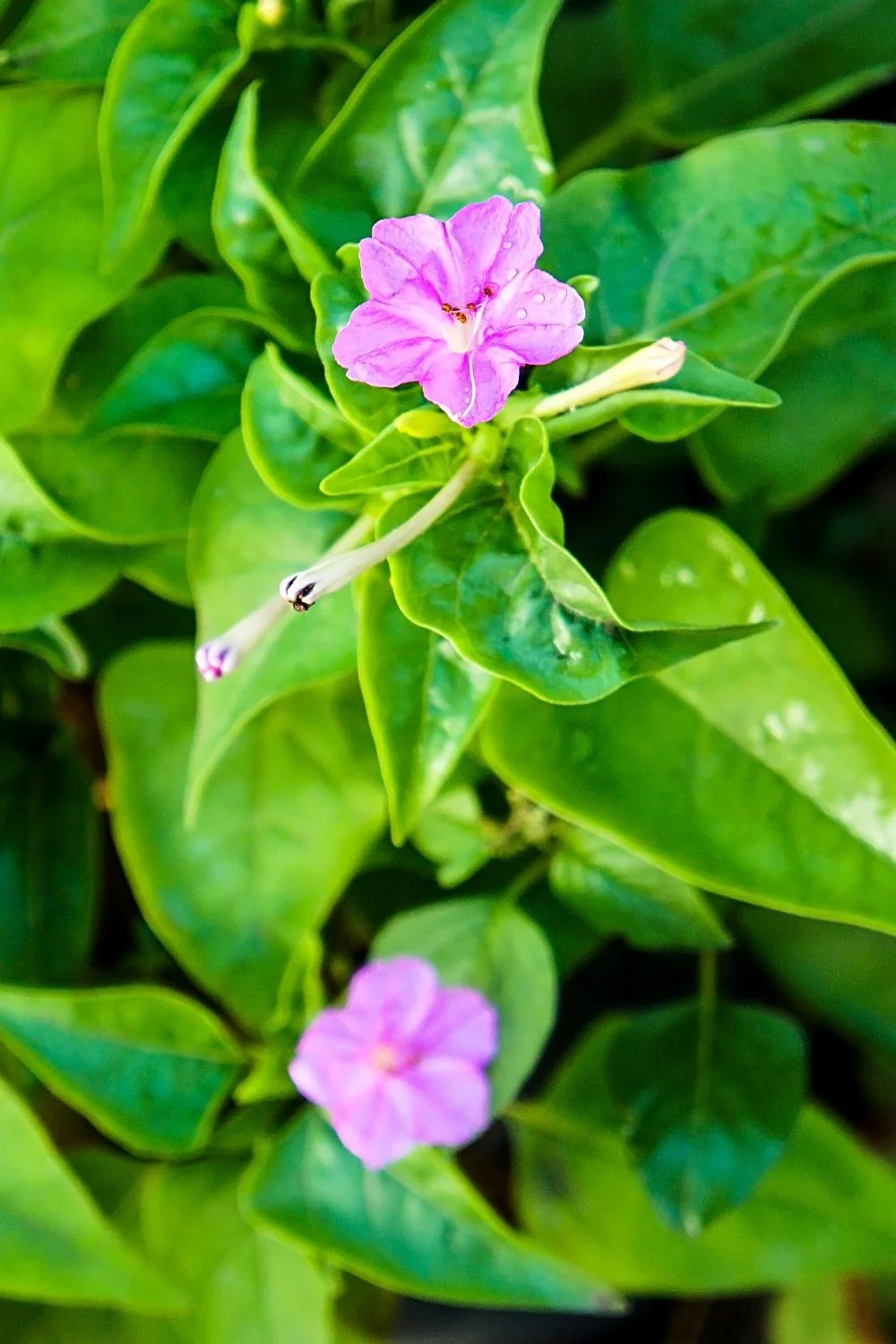
With its stunning trumpet-shaped flowers, Marvel-of-Peru is another great plant to be added to your southeast-facing garden
Marvel-of-Peru is known for its colorful trumpet-shaped flowers. You can grow your Marvel-of-Peru to be bushy and tall, making any garden look vibrant.
Marvel-of-Peru binomial nomenclature and basic plant care requirements include:
- Temperature: Prefers 55 to 65 degrees Fahrenheit and above (13-to-18 degrees Celsius)
- pH: 5.5 to 7.0
- Soil: Needs Chalk, Loam, or Sandy soil
- Fertilizer: Fertilize with manure in spring
- Lighting: full sun exposure
- Growth rate: fast growth
- Humidity: 60% to 70%
- Scientific name: Mirabilis Jalapa
- Family: Nyctaginaceae
7. Egyptian Star Cluster
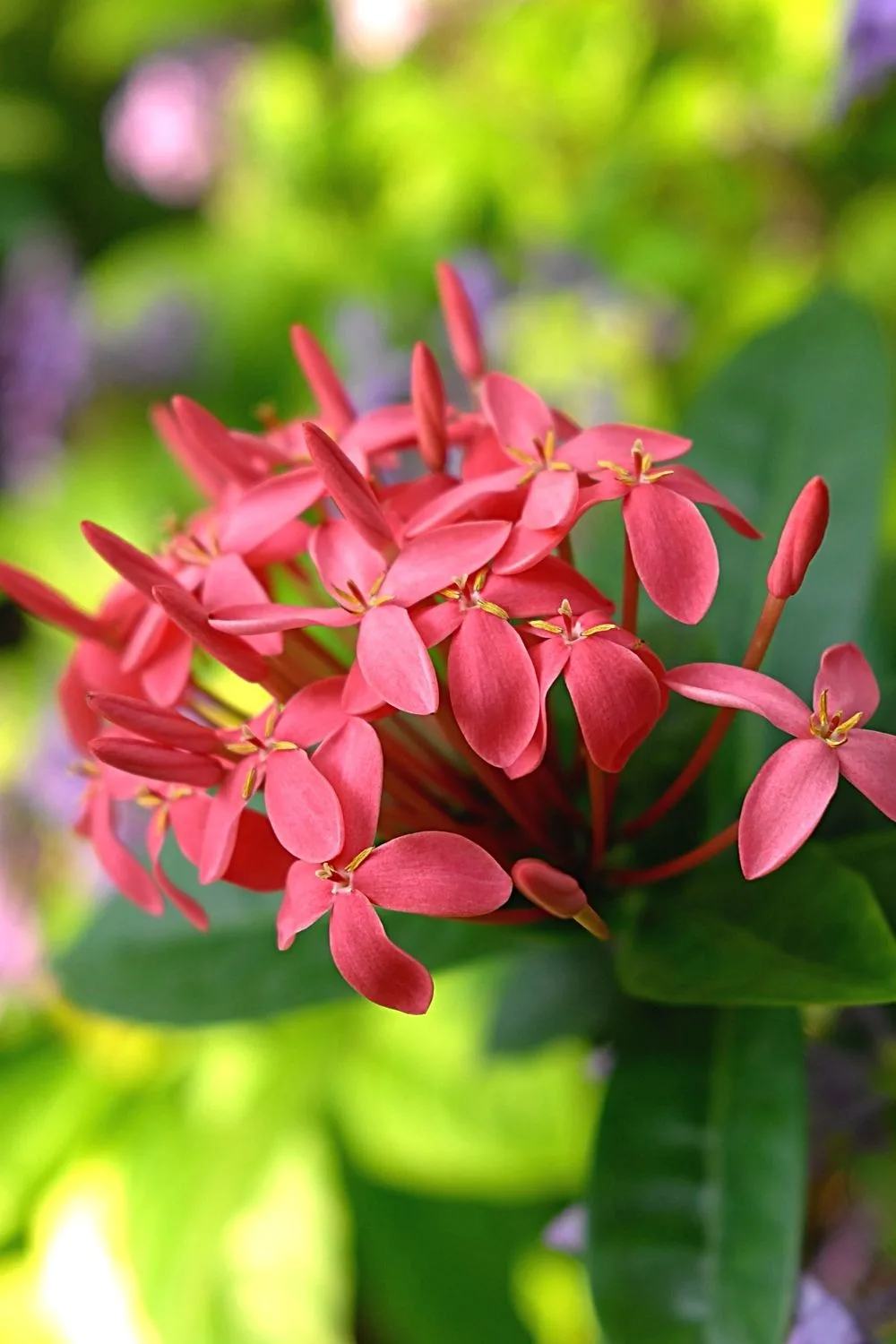
Egyptian Star Cluster has tiny, stunning flowers that grow in clusters that adds beauty to your southeast-facing garden
Egyptian Star Cluster gets its name from the clusters of flowers it grows altogether. These tiny flowers can be found in a variety of colors ranging from red to light purple.
Egyptian Star Clusters binomial nomenclature and basic plant care requirements include:
- Temperature: Prefers 61 to 65 degrees Fahrenheit and above (16-to-18 degrees Celsius)
- pH: 6.0 to 6.5
- Soil: Needs Fertile soil with good drainage
- Fertilizer: Needs fertilization once monthly with a flower fertilizer that’s balanced
- Lighting: three hours of direct sun
- Growth rate: fast growth
- Humidity: 25% to 49%
- Scientific name: Pentas lanceolata
- Family: Rubiaceae
8. Sun Dance

With its white and yellow blooms, you can easily add Sun Dance to your southeast-facing garden
Sun Dance is a large bushy plant that grows white and yellow blossoms. This plant is also known as Mexican orange blossom and is famous for its glossy and aromatic foliage.
Sun Dance blooms from the late part of spring to early summer. These blooms are rich in nectar, which is consumed by the butterflies and bees.
Sun Dance’s binomial nomenclature and basic plant care requirements include:
- Temperature: Prefers 65 to 99 degrees Fahrenheit and above (18-to-37 degrees Celsius)
- pH: 7.2 – 7.8
- Soil: Needs Chalk, Clay, Loam, or Sand soil
- Fertilizer: Fertilize in the spring with compost or well-rotted manure
- Lighting: direct sun
- Growth rate: can be moderate or fast growth
- Humidity: around 49%
- Scientific name: Choisya ternata
- Family: Rutaceae
9. Lavender
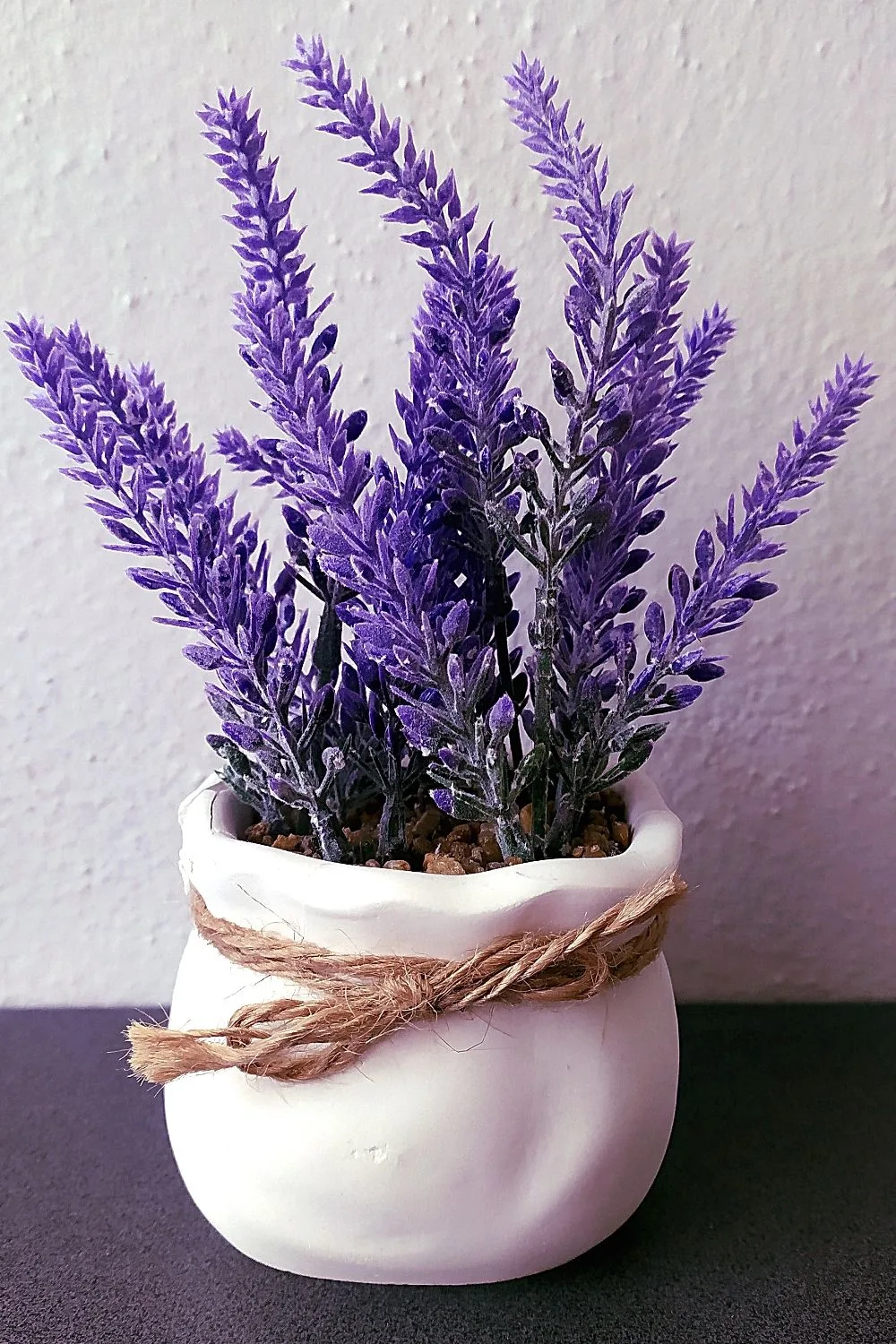
Lavender is known for its scented blooms, hence, it’s a great flower to add to your already beautiful southeast-facing garden
Lavender is famous for its scented flowers that can make any place smell amazing from miles away.
This plant grows on tall stems but can even be planted in pots and kept as a tiny plant.
Lavender’s binomial nomenclature and basic plant care requirements include:
- Temperature: around 55 to 70 degrees Fahrenheit (13-to-21-degree Celsius)
- Fertilizer: Needs fertilization once monthly in summer and spring
- pH: 6.7 to 7.3
- Soil: Needs sandy and well-draining soil
- Lighting: bright light for 3 to 4 hours
- Growth rate: can be moderate or fast growth
- Humidity: around 40%
- Scientific name: Lavandula
- Family: Lamiaceae
10. Borage

Borage has unique flowers and stems in that they have hair-like projections on them, a perfect fit to your southeast facing garden
Borage is a unique plant on this list because of the hair-like projections that grow on the buds and stems. This plant grows adorable blue flowers that have reddish-brown centers.
Borage is not just a beautiful plant; it is also beneficial for several skin conditions.
Borages seed oil is known to be used in treating conditions like eczema and neurodermatitis.
Borages binomial nomenclature and basic plant care requirements include:
- Temperature: around 60 to 70 degrees Fahrenheit (16-to-21-degree Celsius)
- Fertilizer: Needs fertilization weekly that is diluted with water
- pH: 4.5 to 8.5
- Soil: well-tilled and well-draining
- Lighting: full sun to partial shade
- Growth rate: can be moderate or fast growth
- Humidity: can survive in a range of humid conditions
- Scientific name: Borago officinalis
- Family: Boraginaceae
11. Chives
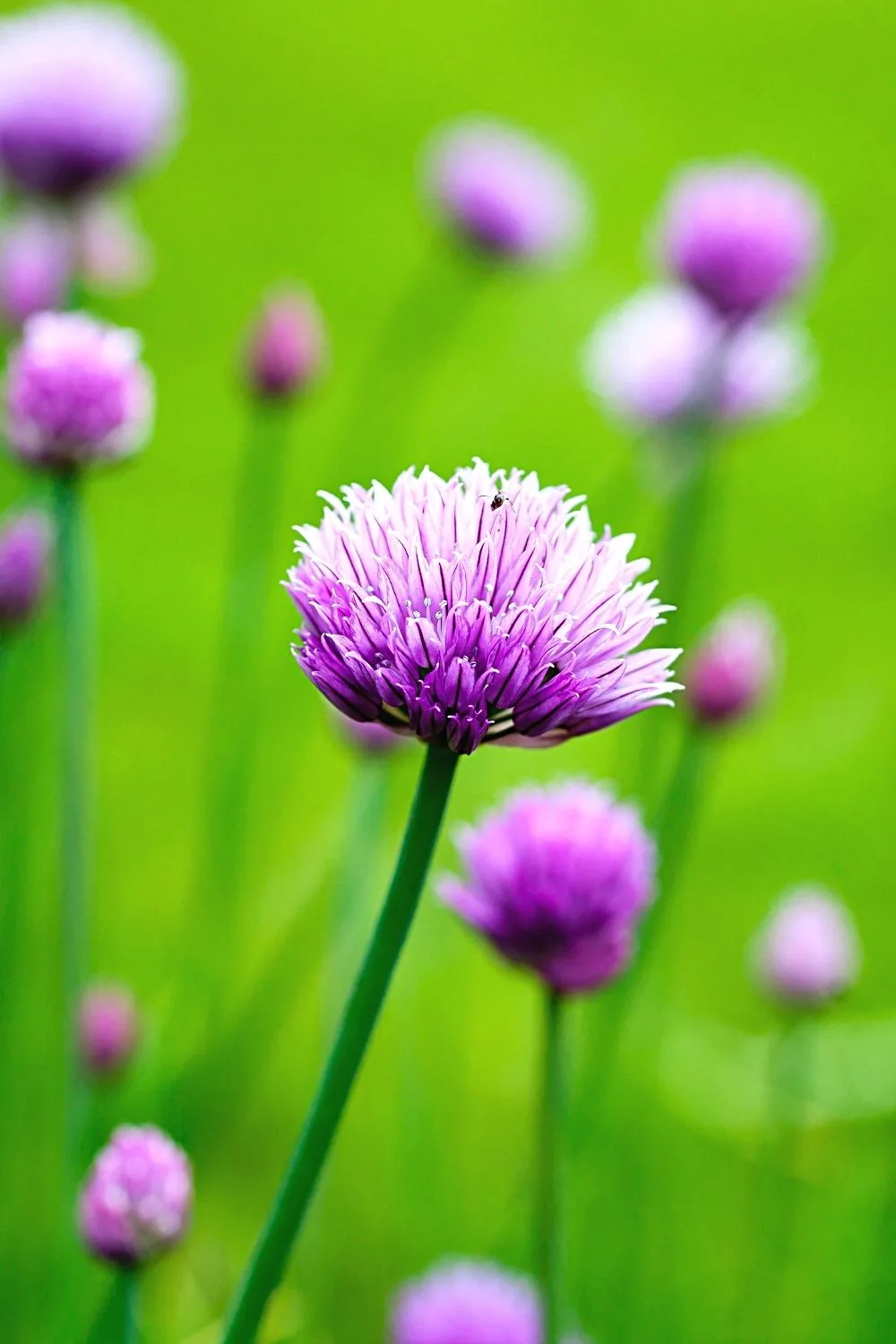
Chives. with its blooms having tiny petals on them, is another plant you can add to your southeast facing garden
Chives are a common food ingredient but are also grown in gardens because of their thin and slender blue-green leaves.
This plant also blooms purple flowers that have tiny petals on them, and these flowers are also edible.
Chives binomial nomenclature and basic plant care requirements include:
- Temperature: around 40 to 85 degrees Fahrenheit (4-to-29-degree Celsius)
- Fertilizer: Needs fertilizer every spring following the first growing season
- pH: 6.0 to 7.0
- Soil: well-drained soil rich in organic matter
- Lighting: full sun to partial shade
- Growth rate: can be moderate or fast growth
- Humidity: around 40% relative humidity
- Scientific name: Allium Schoenoprasum
- Family: Amaryllidaceae
12. Bay Laurel

If you’re looking to grow a plant into a large tree or shrub in your southeast facing garden, Bay Laurel is one choice you shouldn’t miss
Bay Laurel can be grown into a tree or a large shrub that has long smooth and green leaves.
While this plant does grow small yellow flowers, its main attraction is its foliage. But, keep your cats as far away as you can from Bay Laurel as it is toxic to them.
Bay Laurel’s binomial nomenclature and basic plant care requirements include:
- Temperature: above 60 degrees Fahrenheit (16+ degrees Celsius)
- Fertilizer: Needs Fertilizer every two weeks from spring until August
- pH: 4.5 to 8.3
- Soil: well-drained soil that is either sandy or rocky
- Lighting: full sun to partial shade
- Growth rate: Moderate to slow growth
- Humidity: around 80% or above
- Scientific name: Laurus nobilis
- Family: Lauraceae
13. Black Bamboo
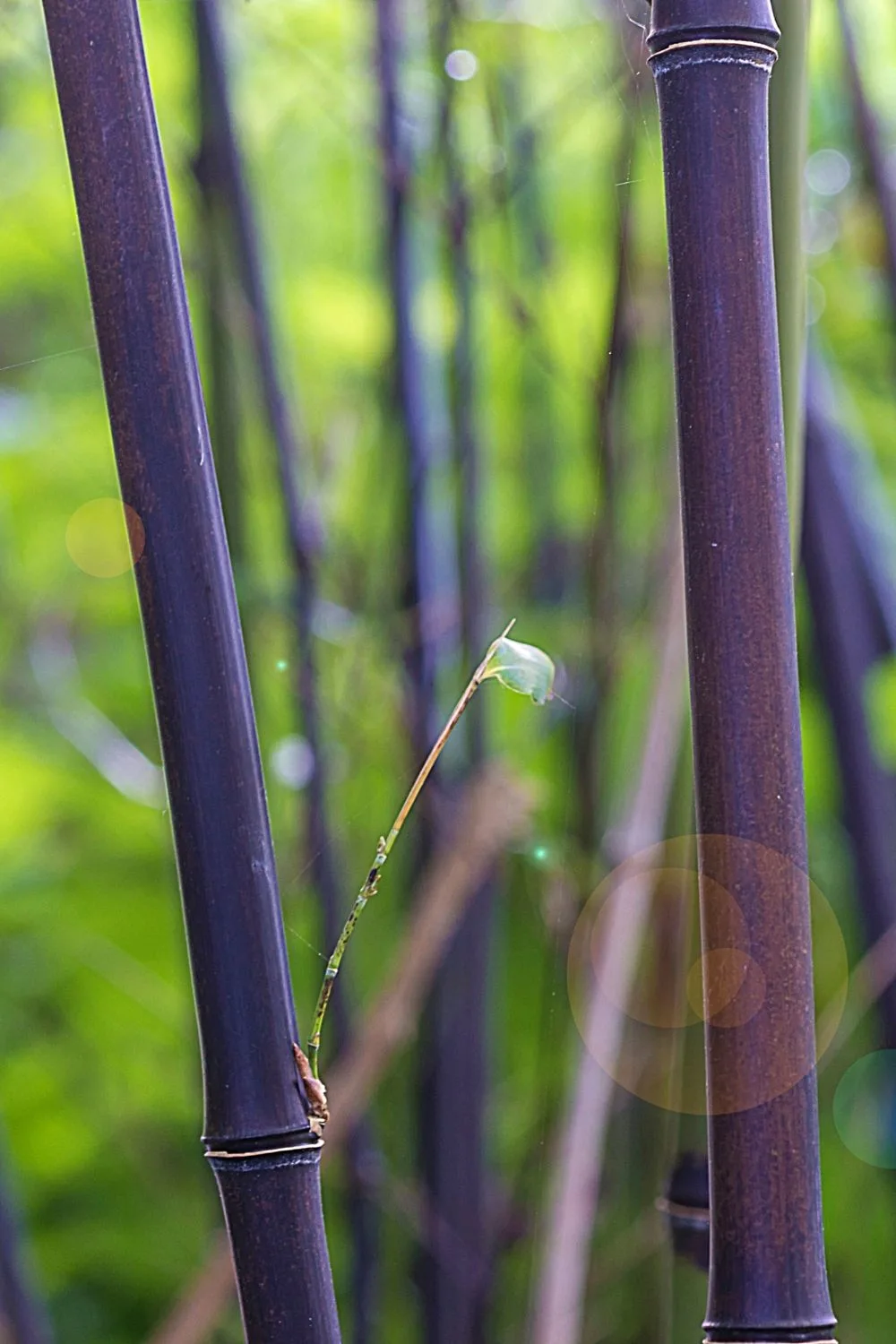
Black Bamboo, with its 25-meter long canes, is a perfect accessory plant to provide shade to your partial-shade requiring plants in your southeast facing garden
Black Bamboo grows long canes that can be 25 meters tall and 30 centimeters wide.
This plant is a huge accessory in any garden and can be used to provide shade for other plants that require partial shade.
Black Bamboo’s binomial nomenclature and basic plant care requirements include:
- Temperature: above 32 degrees Fahrenheit (0 degrees Celsius)
- Fertilizer: Fertilizing is not mandatory for growing black bamboo
- pH: 5.0 to 7.5
- Soil: Well-draining, moist, and loamy soil
- Lighting: full sun to partial shade
- Growth rate: Moderate to slow growth
- Humidity: No specific requirements
- Scientific name: Phyllostachys nigra
- Family: Poaceae
14. Silver Spear
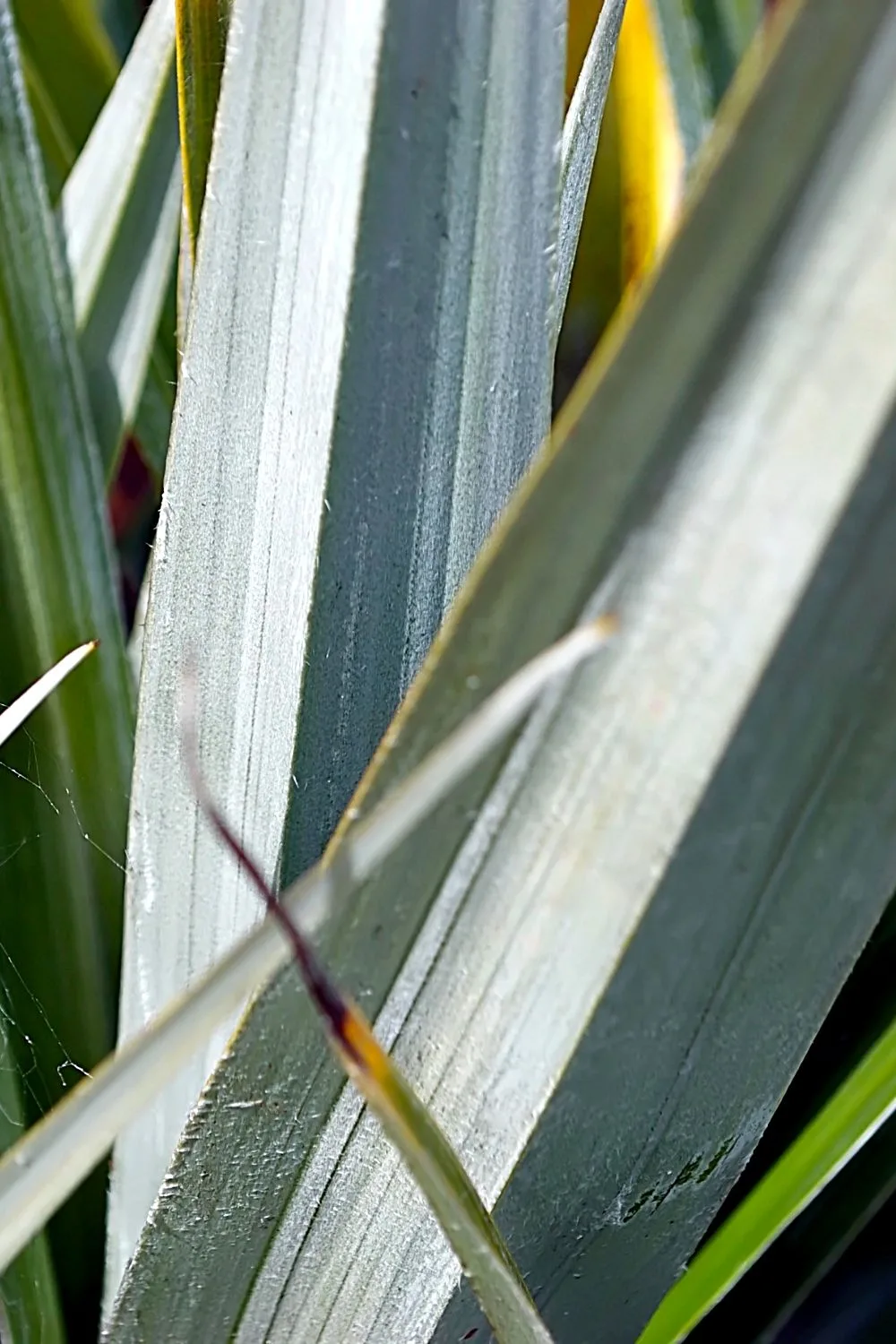
The Silver Spear’s long and sharp leaves, is an evergreen plant you can add to your southeast facing garden
Silver Spear is a short, evergreen plant that is known for its long and sharp leaves. This plant can even be grown semi-submerged in ponds and can survive a wide range of conditions.
Silver Spear’s binomial nomenclature and basic plant care requirements include:
- Temperature: needs to stay above 32 degrees Fahrenheit (0 degrees Celsius)
- Fertilizer: Fertilizing is not mandatory
- pH: 6.1 to 6.5
- Soil: needs Clay, Loamy, or Sandy soil
- Lighting: Full Sun to Partial Shade
- Growth rate: can be moderate or fast growth
- Humidity: No specific requirements
- Scientific name: Astelia chathamica
- Family: Asteliaceae
15. Windmill Palm
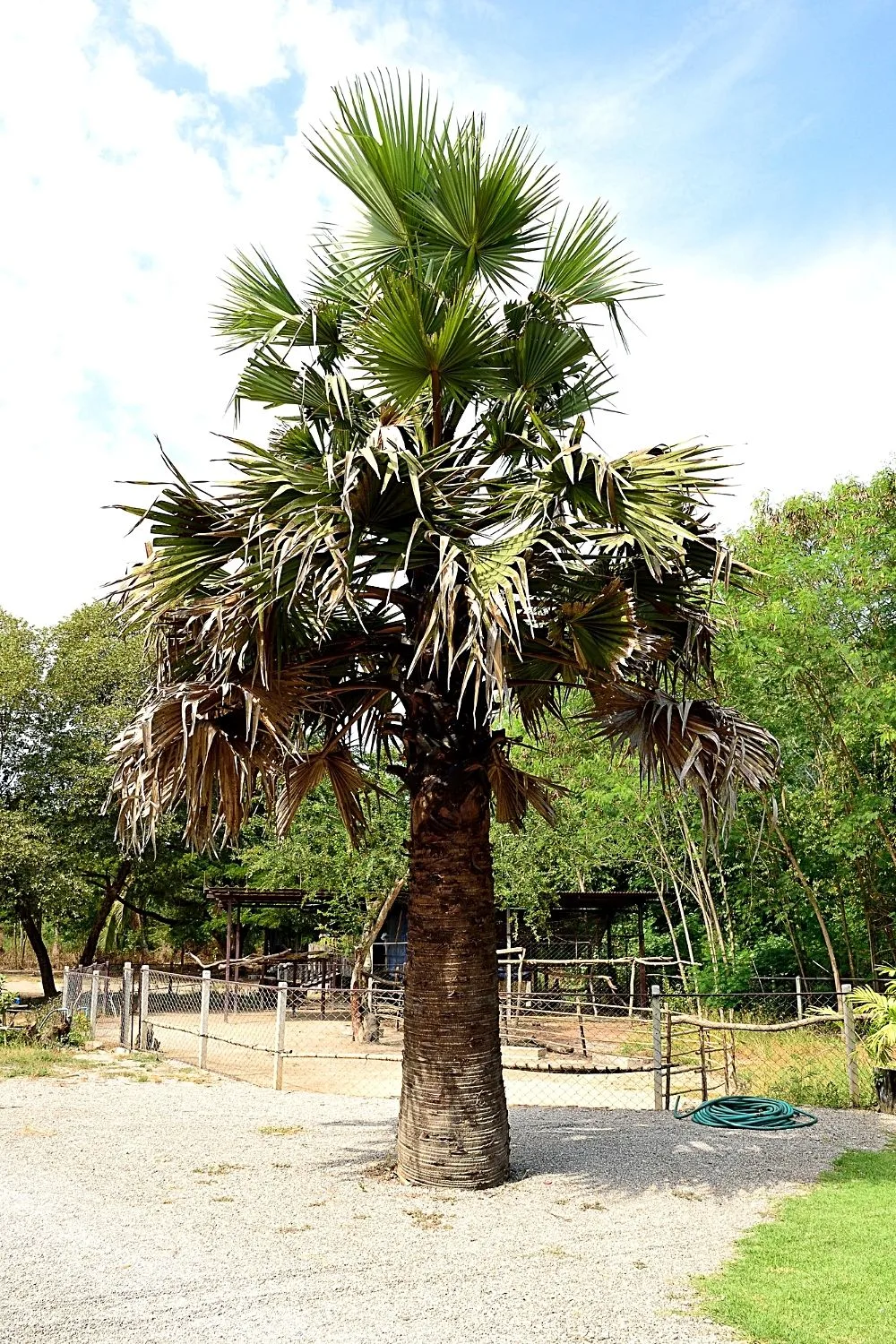
Windmill Palm is a great centerpiece plant for your southeast facing garden
Windmill Palm, also known as the Chinese Windmill Palm, is a tall and gorgeous plant that can be the centerpiece in any garden.
This beautiful plant is capable of growing into a tall tree or remaining as a tiny tree within pots as well.
Windmill Palm binomial nomenclature and basic plant care requirements include:
- Temperature: cannot survive below 60 degrees Fahrenheit (16 degrees Celsius)
- Fertilizer: fertilizer per month during the growing season
- pH: 5.5 to 7.5
- Soil: needs good-draining soil
- Lighting: Full Sun to Partial Shade
- Growth rate: Slow growth
- Humidity: No specific requirements
- Scientific name: Trachycarpus fortunei
- Family: Arecaceae
16. Angelica Gigas
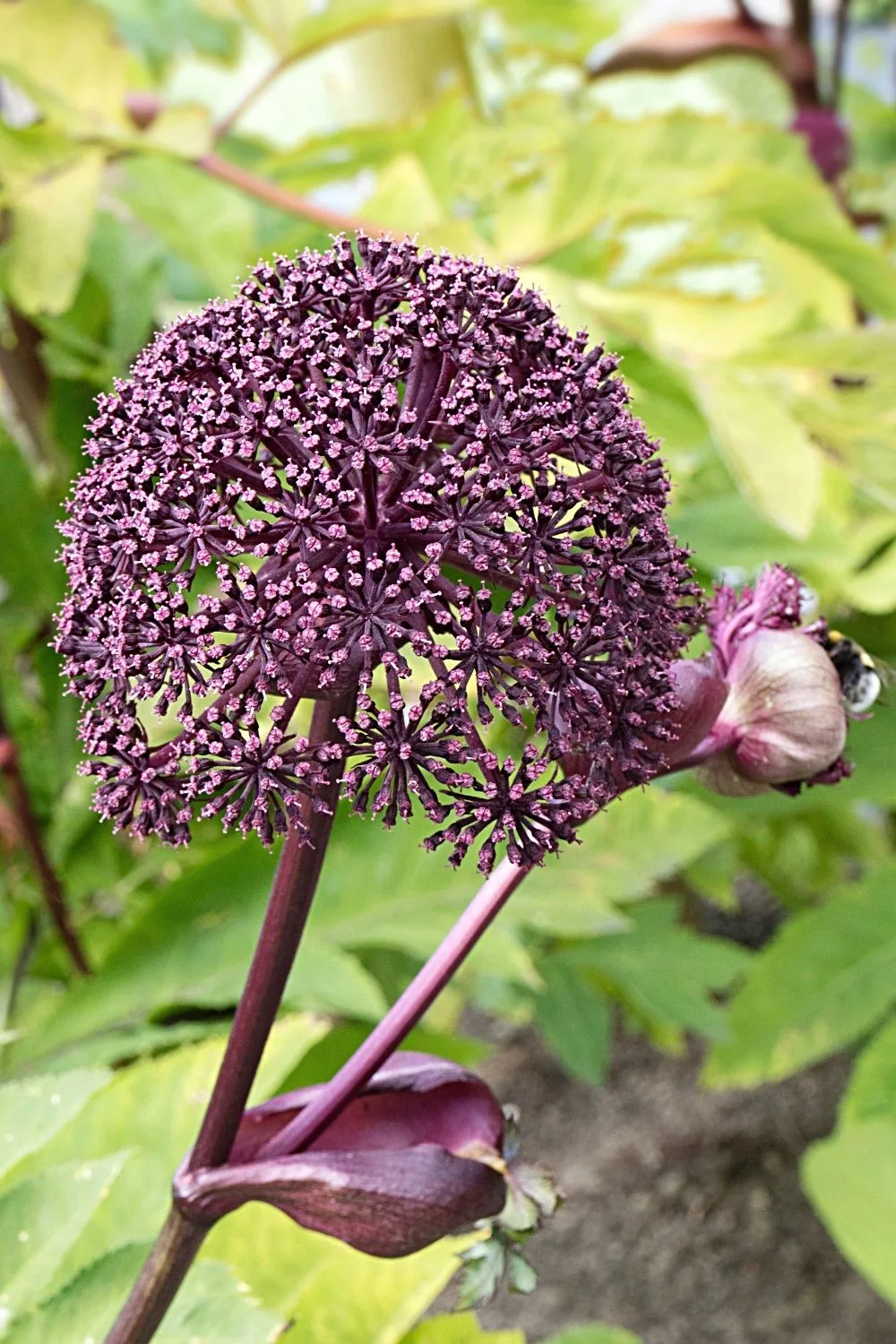
Commonly found in Korea and China, Angelica Gigas grows clusters of purple flowers that can sometimes turn white, a great addition to your gorgeous southeast facing garden
Angelica Gigas is famous for its clusters of purple flowers that can sometimes even bloom as white flowers.
This plant is a short-lived perennial plant that is most commonly found in China and Korea.
Angelica Gigas binomial nomenclature and basic plant care requirements include:
- Temperature: between 60 to 65 degrees Fahrenheit (16-to-18 degrees Celsius)
- Fertilizer: needs slow-release fertilizer
- pH: 5.5 to 7.5
- Soil: needs deep, moist, fertile, and loamy soil
- Lighting: Full Sun to Partial Shade
- Growth rate: fast growth
- Humidity: No specific requirements
- Scientific name: Angelica Gigas
- Family: Umbellifers
17. Purple Coneflower
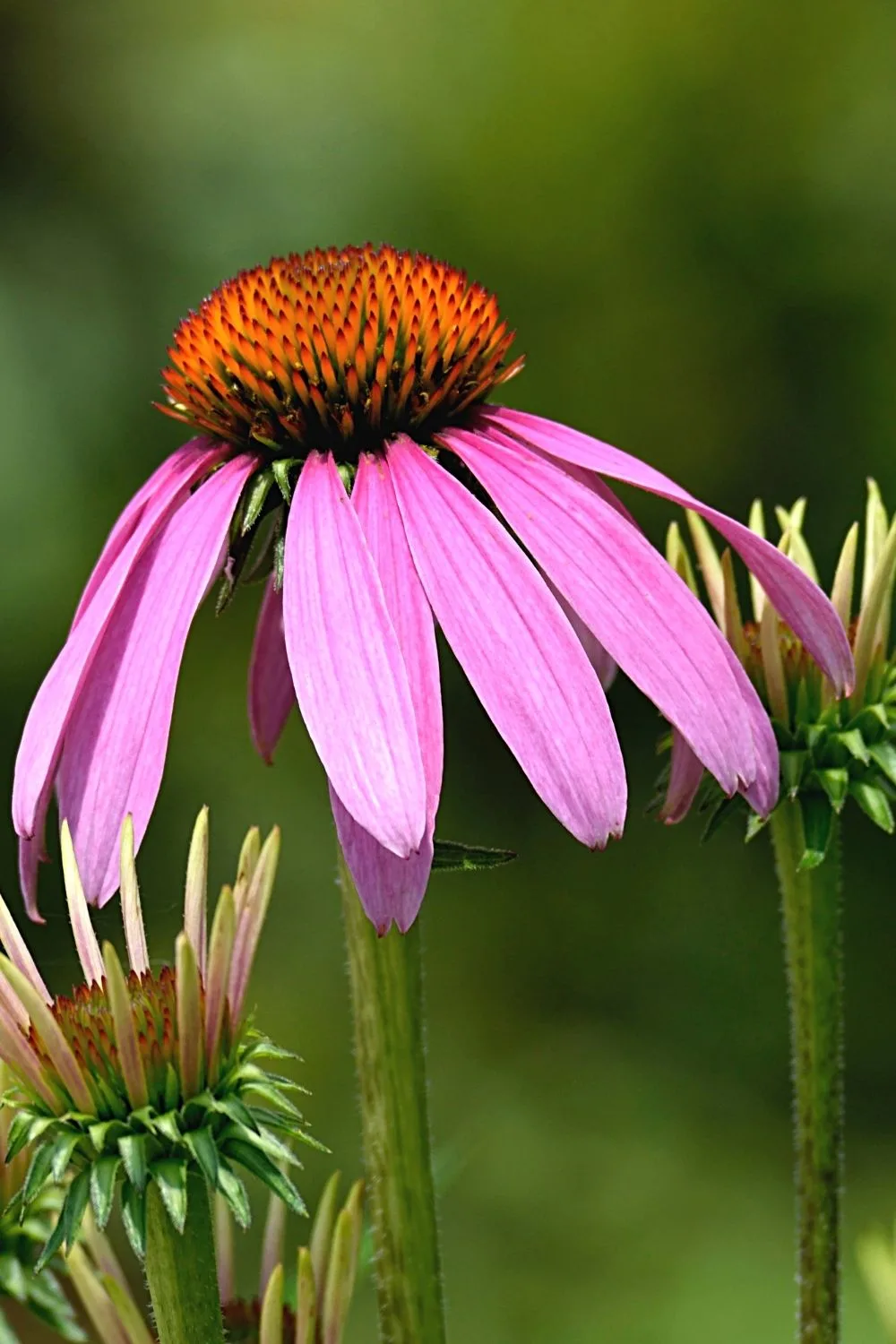
Purple Coneflower is part of the Sunflower family of plants that you can easily blend into your southeast facing garden
Purple Coneflower is a tiny flowering plant that belongs to the sunflower family. Their appearance is that of a tiny sunflower with purplish-pink petals.
Purple Coneflower seems like a plant that will spread all over your garden once planted. But this plant does not grow anywhere else unless it has been planted in that location.
Purple Coneflower’s binomial nomenclature and basic plant care requirements include:
- Temperature: between 60 to 68 degrees Fahrenheit (16-to-20 degrees Celsius)
- Fertilizer: Native coneflowers don’t need fertilization
- pH: 6.5 to 7.2
- Soil: survives in sandy, rocky, and clay soils
- Lighting: Full Sun to Partial Shade
- Growth rate: fast growth
- Humidity: No specific requirements
- Scientific name: Echinacea purpurea
- Family: Asteraceae
18. Johnson’s Blue Geranium

Johnson’s Blue Geranium grows large lavender-colored blooms that adds a pop of color to your southeast facing garden
Johnson’s Blue Geranium is a cranesbill geranium that grows large lavender flowers that have large veins.
The flowers are this plant’s main asset since its blue color pops out more compared to any other blue flowering plant.
Johnson’s Blue Geranium binomial nomenclature and basic plant care requirements include:
- Temperature: between 60 to 75 degrees Fahrenheit (16-to-24 degrees Celsius)
- Fertilizer: needs fertilizer from early summer to late summer
- pH: 5.0 to 8.0
- Soil: survives in moist, organic soils
- Lighting: Full Sun to Partial Shade
- Growth rate: fast growth
- Humidity: No specific requirements
- Scientific name: Johnson’s Blue Geranium
- Family: Geranium – Cranesbills
19. Argentinian Vervain

Argentinian Vervain is known for its clusters of tiny purple flowers, adding another colorful plant to your southeast facing garden
Argentinian Vervain is known for tiny clusters of flowers it blooms together on one stem. The flowers have a stunning purple color to them.
Argentinian Vervain binomial nomenclature and basic plant care requirements include:
- Temperature: between 65 to 75 degrees Fahrenheit (18-to-24-degree Celsius)
- Fertilizer: Needs Organic matter mixed into the soil
- pH: 5.8 to 7.2
- Soil: Needs well-draining soil
- Lighting: bright light for 8 hours
- Growth rate: Fast
- Humidity: 40% to 60%
- Scientific name: Verbena Bonariensis
- Family: Verbenaceae
20. Chamomile
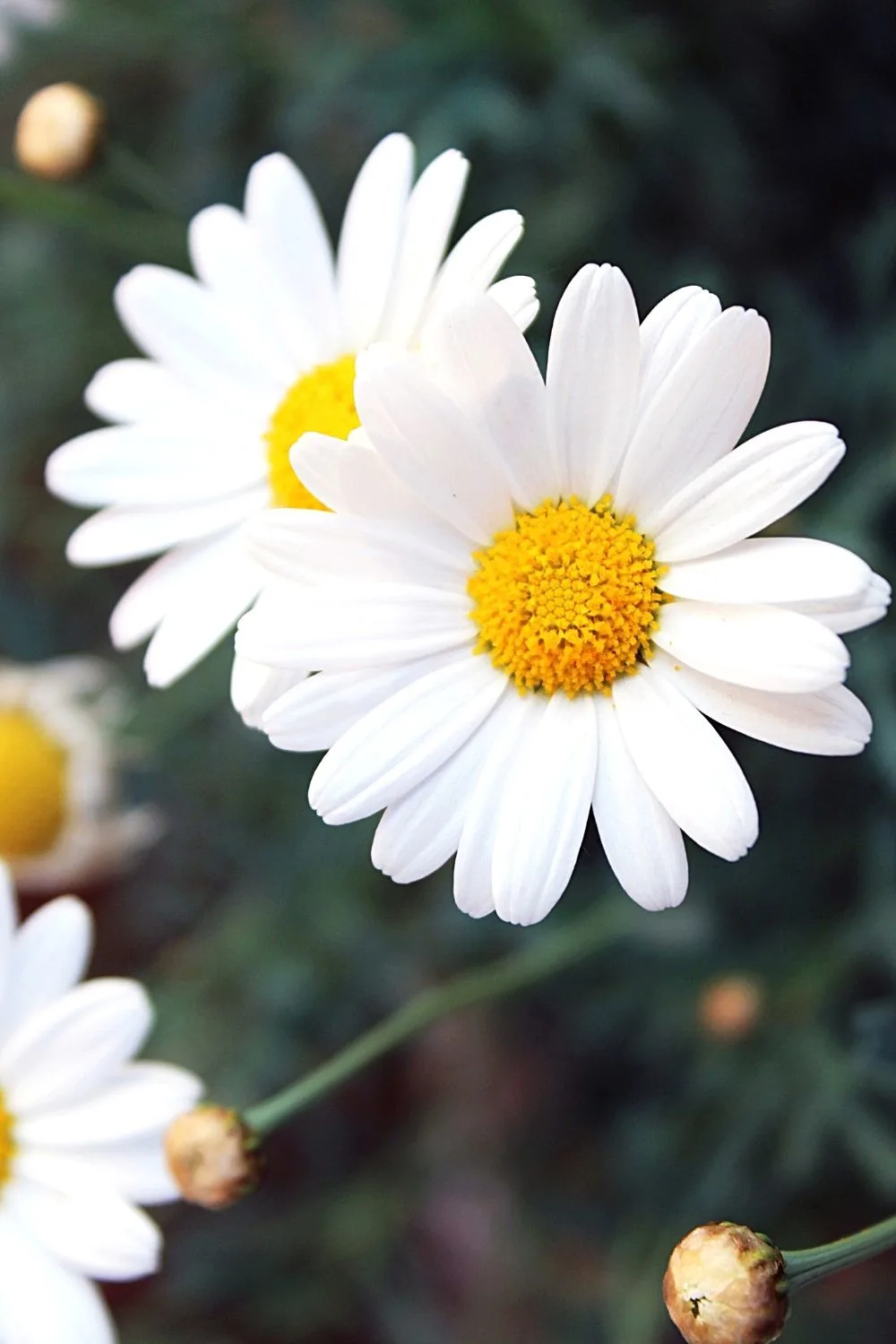
If your looking for another relaxing plant to add to your southeast facing garden, plant Chamomile
Chamomile is a common tea ingredient used when you need some relaxation. This plant has an appearance similar to daisies because of its tiny white flowers with yellow centers.
Chamomile binomial nomenclature and basic plant care requirements include:
- Temperature: between 68 to 86 degrees Fahrenheit (20-to-30-degree Celsius)
- Fertilizer: Needs well-rotted manure for fertilization
- pH: 5.6 to 7.5
- Soil: Needs rich, organic soil
- Lighting: full sun to partial shade
- Growth rate: Fast growth
- Humidity: thrive in low humid conditions
- Scientific name: Matricaria chamomilla
- Family: Asteraceae
21. Japanese Banana

Now, if you’re raring to add an edible plant to your southeast facing garden, Japanese Banana is a great choice
Japanese Banana, also known as Hardy Banana, is a part of the flowering plant family known as Musaceae.
It is known for its large green leaves that have a smooth and shiny appearance to them.
Japanese Banana binomial nomenclature and basic plant care requirements include:
- Temperature: between 75 to 95 degrees Fahrenheit (24-to-35-degree Celsius)
- Fertilizer: Needs fertilization once a month from spring to summer
- pH: 5.5 to 6.5
- Soil: likes nutrient-rich soil that is mixed with peat, Perlite, and vermiculite
- Lighting: bright light for 12 hours
- Growth rate: Fast growth rate
- Humidity: 60% to 65%
- Scientific name: Musa
- Family: Musaceae
22. Chinese Wisteria
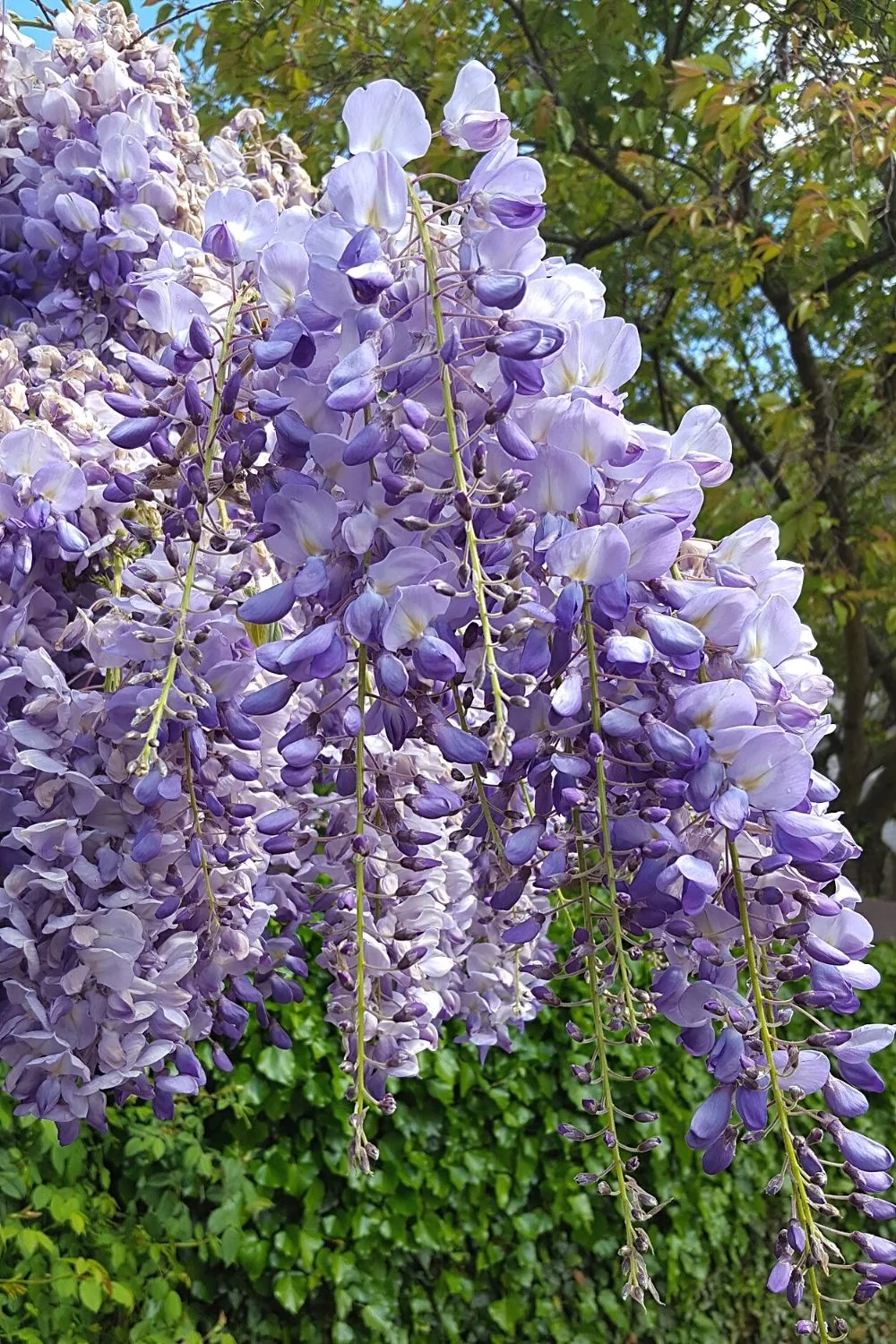
If you’re looking for a mystical-looking plant to add to your southeast facing garden, then Chinese Wisteria is your plant of choice
Chinese Wisteria is a mystical-looking plant that instantly makes you feel like you are in another world.
It can be planted indoors and outdoors as a miniature tree or can also be grown outdoors to its full height.
Chinese Wisteria has bluish-purple flowers that look beautiful dangling off of a supporting beam. Even the stems add a stunning look to this plant with their fine white hairs.
Chinese Wisteria’s binomial nomenclature and basic plant care requirements include:
- Temperature: above 20 degrees Fahrenheit (-6 degrees Celsius)
- Fertilizer: Needs a low-nitrogen fertilizer once every year
- pH: 6.0 to 7.0
- Soil: likes Medium moist and well-draining soil
- Lighting: full sun
- Growth rate: slow growth
- Humidity: 80% to 90%
- Scientific name: Wisteria Sinensis
- Family: Legumes
23. Foxtail Lily
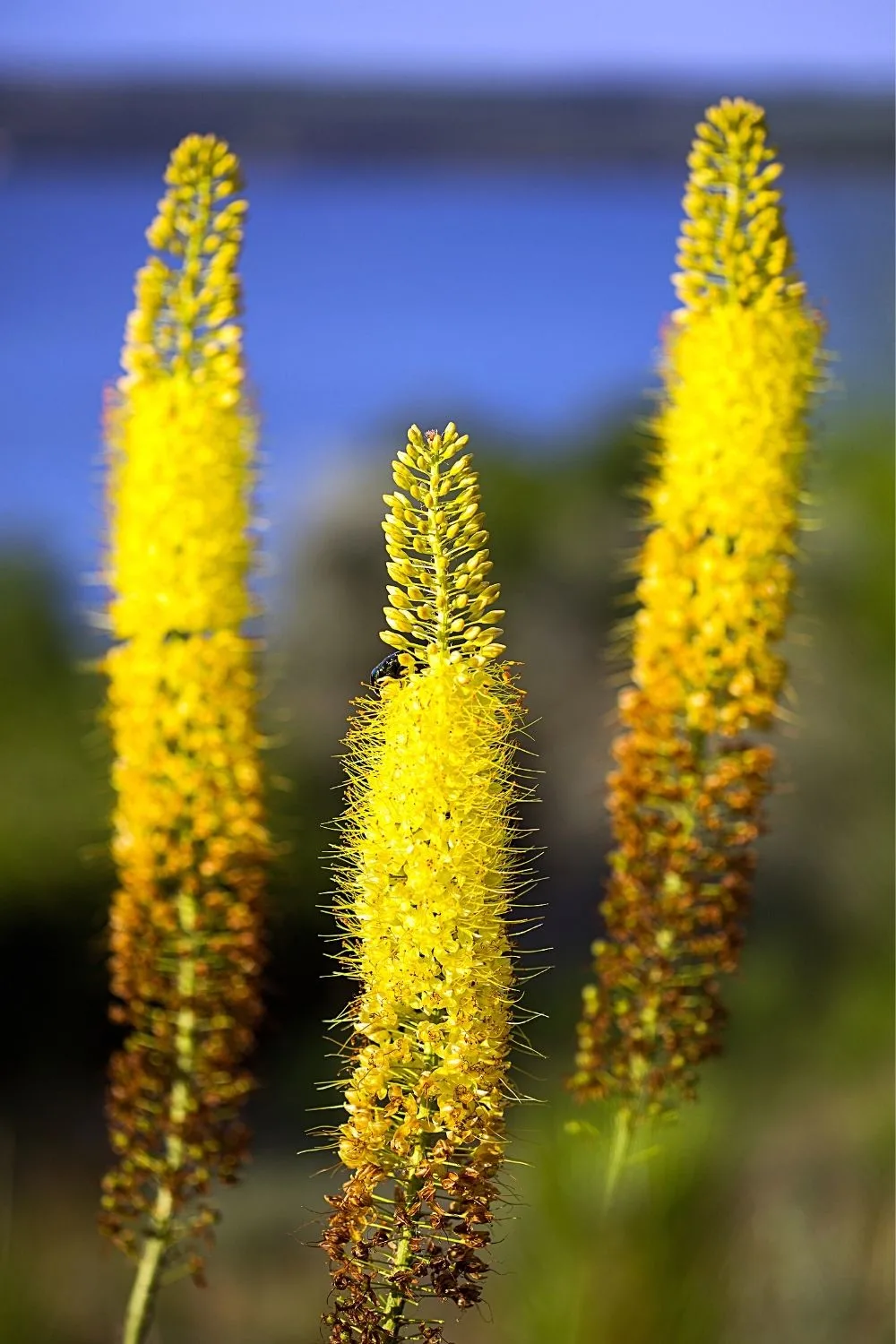
Foxtail Lily, aka Desert Candles, is another plant that you can add to your colorful southeast facing garden
Foxtail Lily, also commonly known as desert candles, is a unique plant since it actually looks like a candle.
This plant grows spikes that come in various color shades that range from orange to pink.
Foxtail Lily’s binomial nomenclature and basic plant care requirements include:
- Temperature: between 55 to 65 degrees Fahrenheit (13-to-18 degrees Celsius)
- Fertilizer: Needs a liquid fertilizer regularly
- pH: 6.0 to 7.0
- Soil: likes well-drained soil
- Lighting: full sun
- Growth rate: fast to slow growth
- Humidity: 80% to 90%
- Scientific name: Eremurus stenophyllous
- Family: Asphodelaceae
24. Crocosmia Lucifer
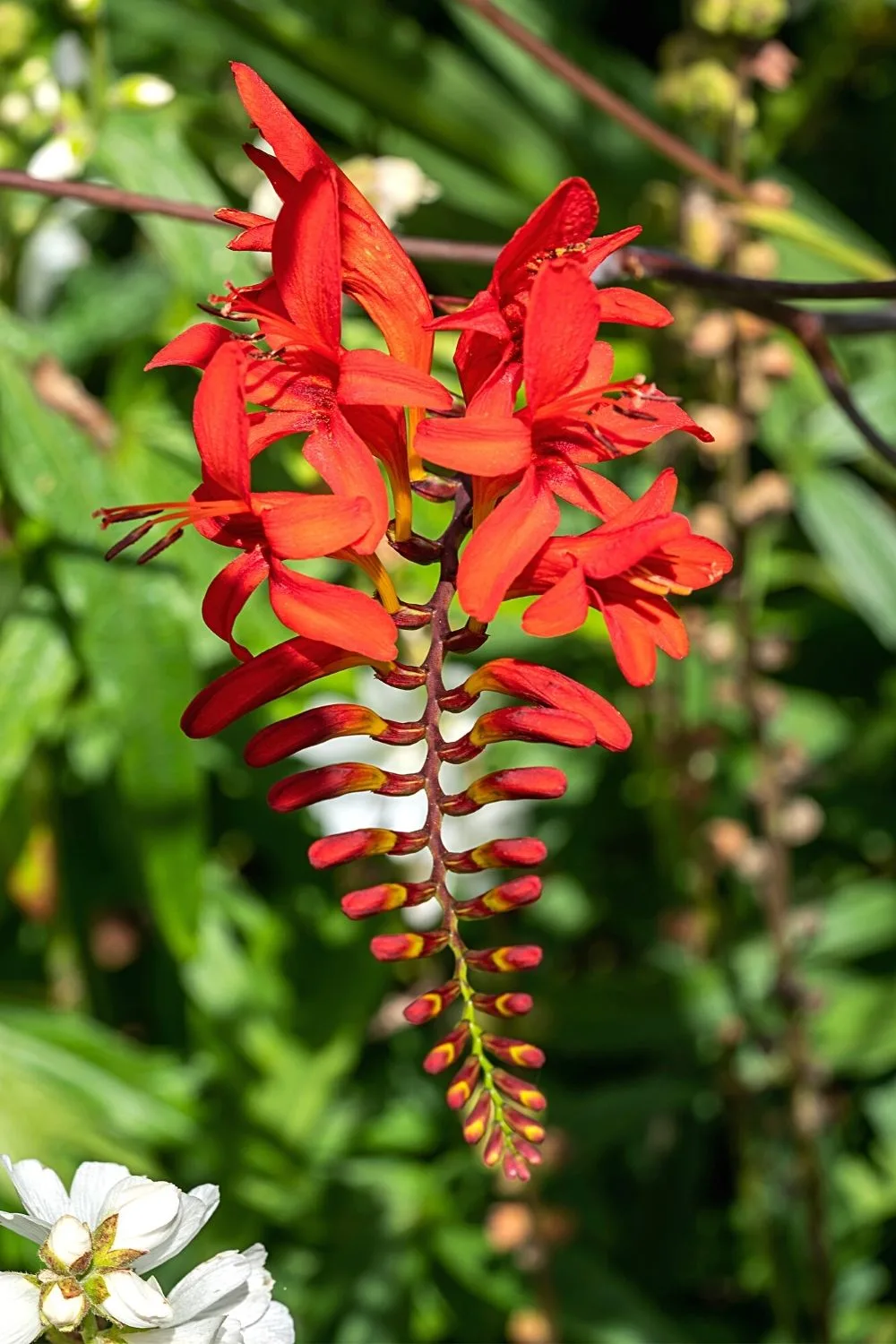
Crocosmia Lucifer adds a pop of red to your southeast facing garden with its red blooms
Crocosmia Lucifer is an upright, herbaceous perennial plant that grows bright red flowers.
It has long, sharp leaves that stand out even more with the bright red flowers growing with them.
Crocosmia Lucifer’s binomial nomenclature and basic plant care requirements include:
- Temperature: between 55 to 65 degrees Fahrenheit (13-to-18 degrees Celsius)
- Fertilizer: Needs a balanced fertilizer
- pH: 6.6 to 7.5
- Soil: likes well-drained soil
- Lighting: full sun
- Growth rate: can be moderate or fast growth
- Humidity: can survive in a range of humid conditions
- Scientific name: Crocosmia Lucifer
- Family: Iridaceae
25. Allium
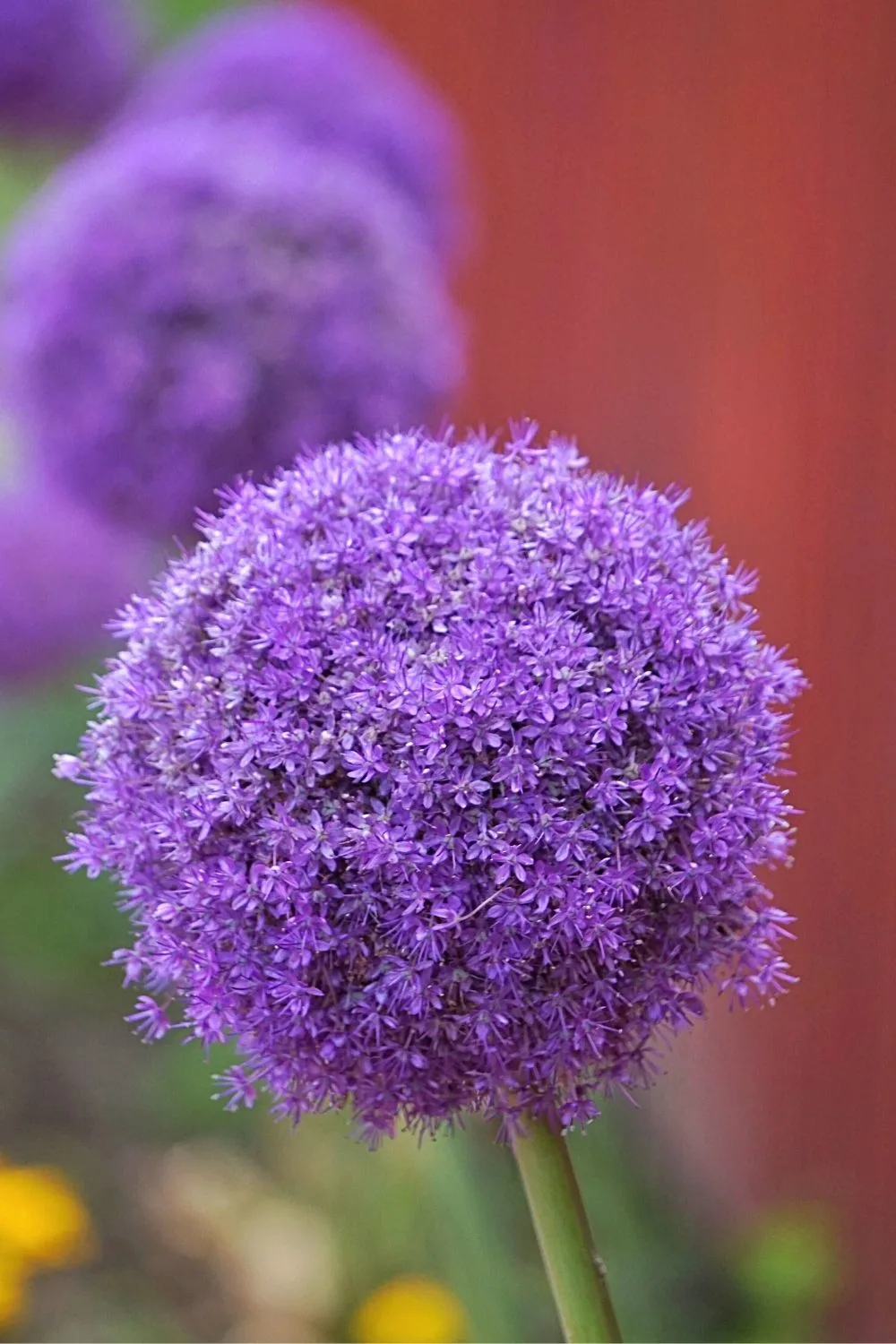
Allium has interesting pompom-shaped flowers that looks great on your southeast facing garden
Allium plant grows tall stems with pompom-like flowers that come in a variety of colors ranging from purple to light pink.
Allium’s binomial nomenclature and basic plant care requirements include:
- Temperature: between 50 to 70 degrees Fahrenheit (10-to-21 degrees Celsius)
- Fertilizer: Alliums do not need excessive fertilizer
- pH: 5.5 to 6.5
- Soil: likes well-drained soil
- Lighting: full sun
- Growth rate: can be moderate or fast growth
- Humidity: 50% to 90%
- Scientific name: Allium
- Family: Amaryllidaceae
26. Himalayan Lily
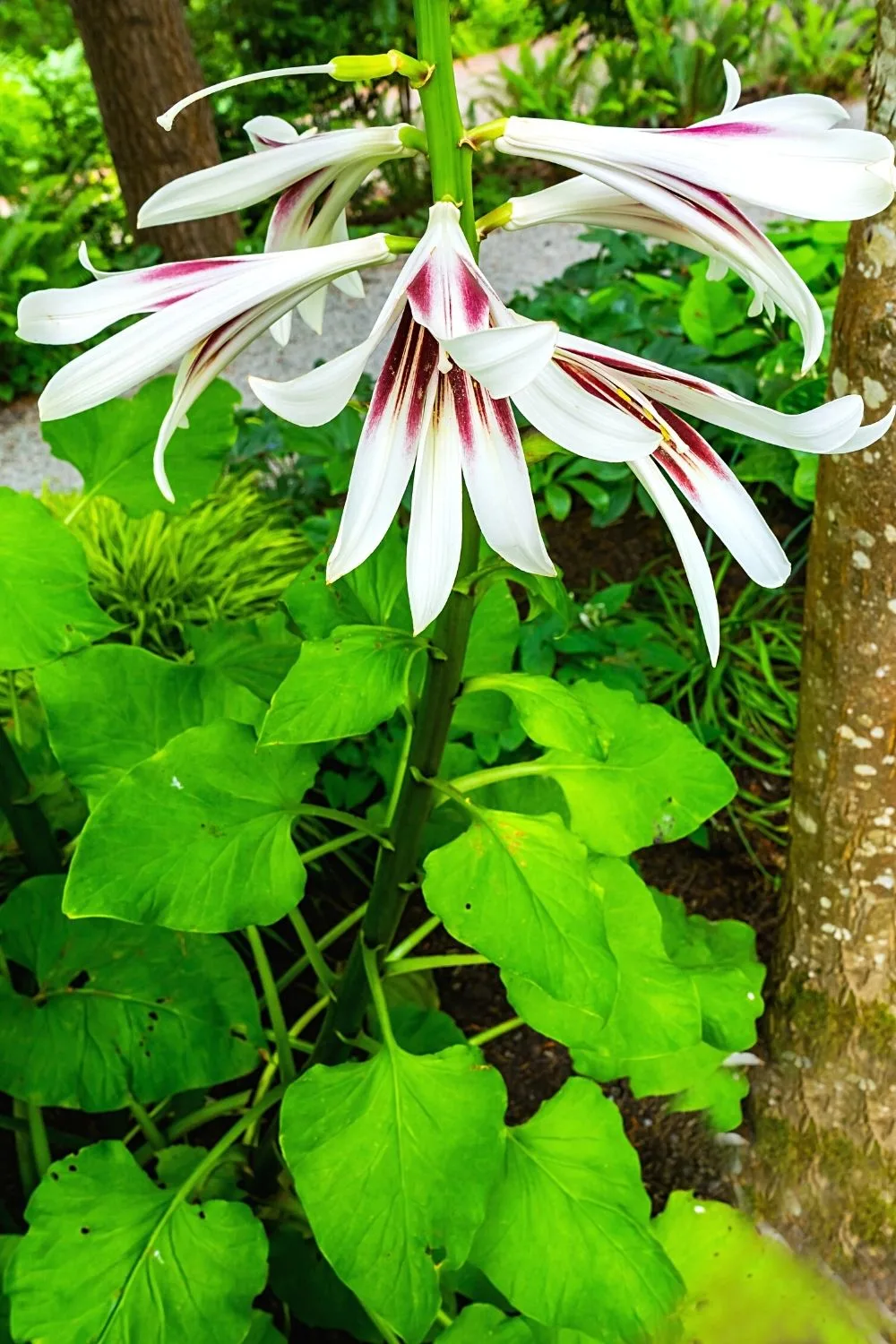
Himalayan Lily has white, trumpet-shaped flowers that is another colorful addition to your southeast facing garden
Himalayan Lily is grown for its stunning white, trumpet-shaped flowers. These white flowers have a maroon gradient in the center that makes them look even more beautiful and vibrant.
Himalayan Lily’s binomial nomenclature and basic plant care requirements include:
- Temperature: between 50 to 70 degrees Fahrenheit (10-to-21 degrees Celsius)
- Fertilizer: needs light fertilizer every month
- pH: 6.0 to 7.0
- Soil: likes Chalk, Clay, Loam, or Sandy soil
- Lighting: full sun
- Growth rate: can be moderate or fast growth
- Humidity: no specific requirements
- Scientific name: Cardiocrinum gigantium
- Family: Liliaceae
27. Winter Daphne
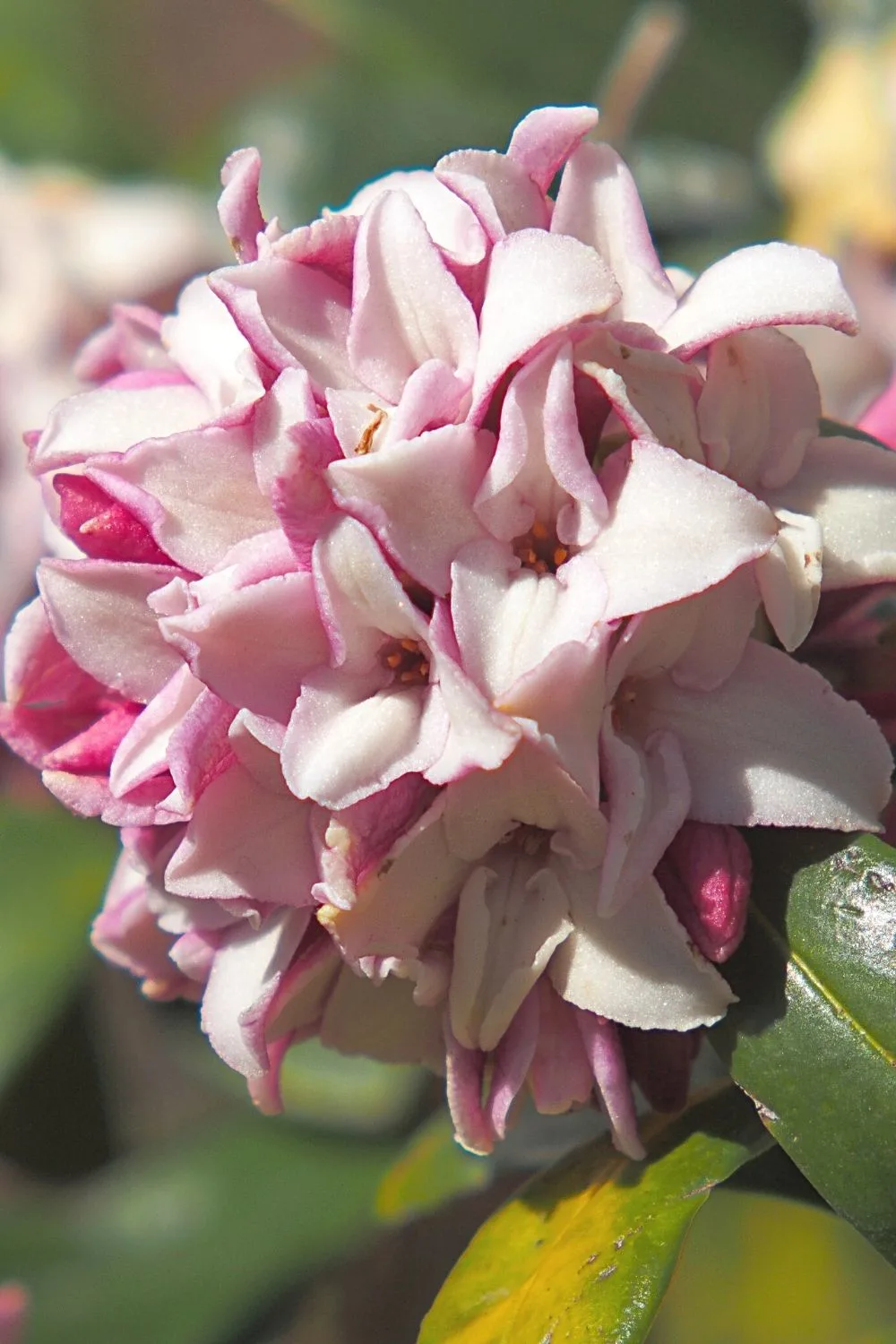
Winter Daphne has white-pink flowers that adds a pastel hue to your colorful southeast facing garden
Winter Daphne is a small, bush-like plant that is known for its tiny clusters of white-pink flowers.
Winter Daphne’s binomial nomenclature and basic plant care requirements include:
- Temperature: between 50 to 70 degrees Fahrenheit (10-to-21 degrees Celsius)
- Fertilizer: fertilize lightly twice a year
- pH: 6.0 to 7.0
- Soil: likes Chalk, Clay, Loam, or Sandy soil
- Lighting: full sun
- Growth rate: can be moderate or fast growth
- Humidity: no specific requirements
- Scientific name: Daphne Odora
- Family: Thymelaeaceae
28. Christmas Box
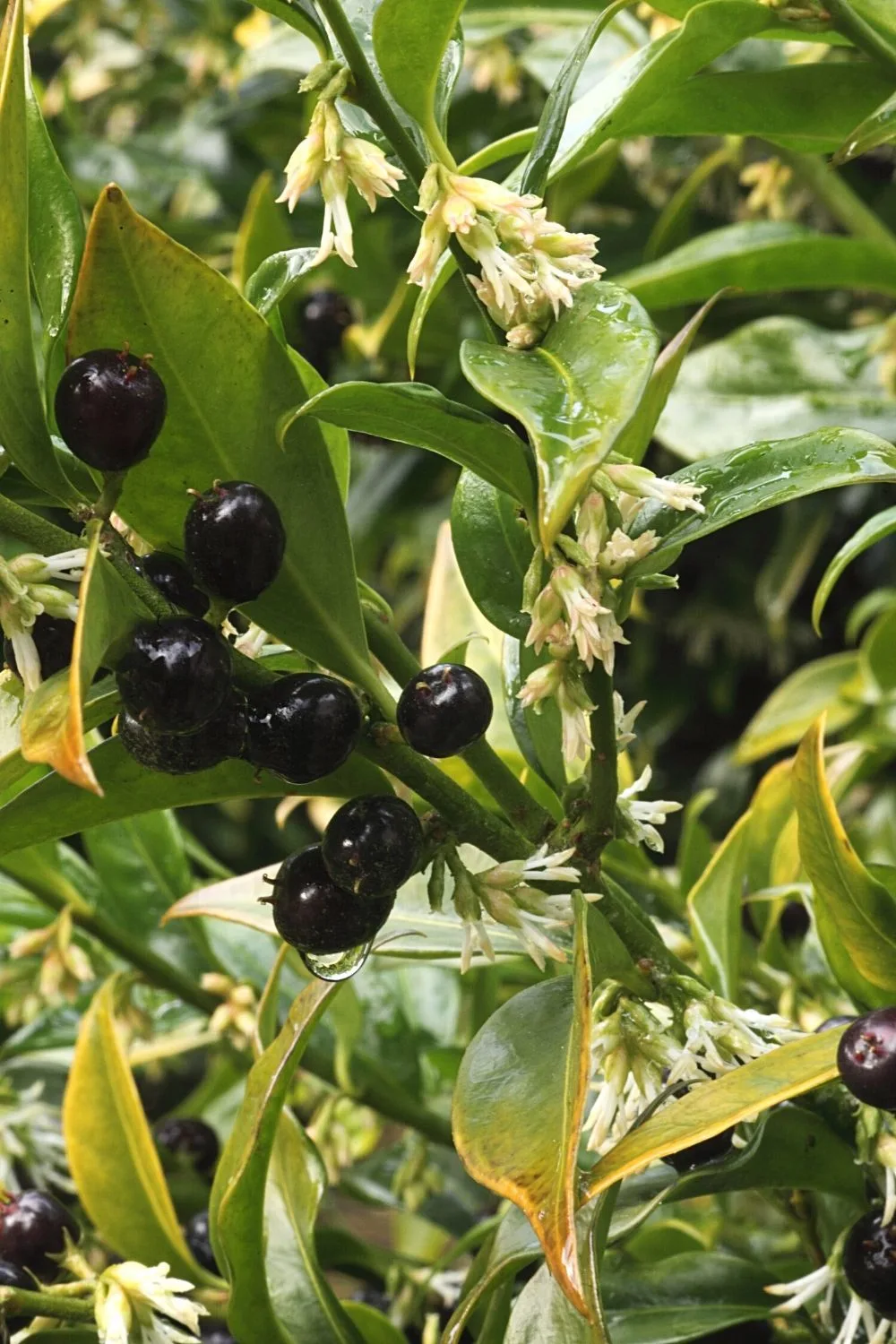
If you want a slow-growing plant to add to your southeast facing garden, Christmas Box is the plant to go
Christmas Box is a slow-growing plant that has tiny leaves and even tinier white flowers.
Christmas Box’s binomial nomenclature and basic plant care requirements include:
- Temperature: between 50 to 60 degrees Fahrenheit (10-to-16 degrees Celsius)
- Fertilizer: fertilize with nitrogen fertilizer
- pH: 5.0 to 7.0
- Soil: likes moderately fertile, moist, humus-rich, well-drained soil
- Lighting: full sun
- Growth rate: can be moderate or fast growth
- Humidity: 30% to 55%
- Scientific name: Sarcococca confusa
- Family: Buxaceae
29. Gertrude Jekyll Rose
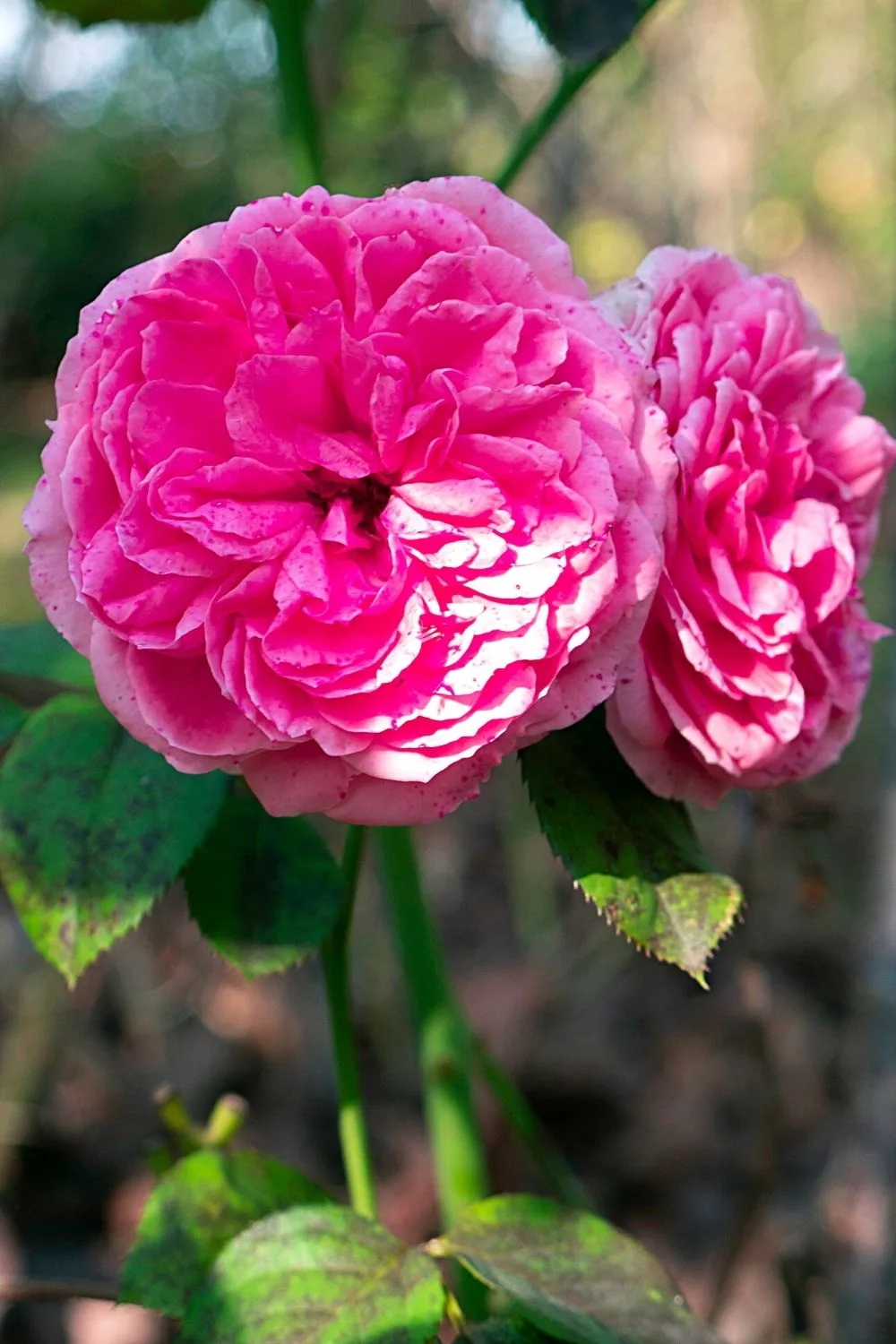
Gertrude Jekyll Rose, aka the English Rose, adds a nice pop of pink to your southeast facing garden
Gertrude Jekyll Rose, also known as the English Rose, is similar to other rose plants. But its petals are pink and have shades of white in them as well.
Gertrude Jekyll Rose binomial nomenclature and basic plant care requirements include:
- Temperature: between 50 to 60 degrees Fahrenheit (10-to-16 degrees Celsius)
- Fertilizer: fertilize with well-rotted manure or compost
- pH: 5.0 to 7.0
- Soil: likes chalk, clay, loam, and sandy soil
- Lighting: full sun
- Growth rate: can be moderate or fast growth
- Humidity: no specific requirements
- Scientific name: Rosa ‘Gertrude Jekyll’
- Family: Rosaceae
30. West Himalayan Birch
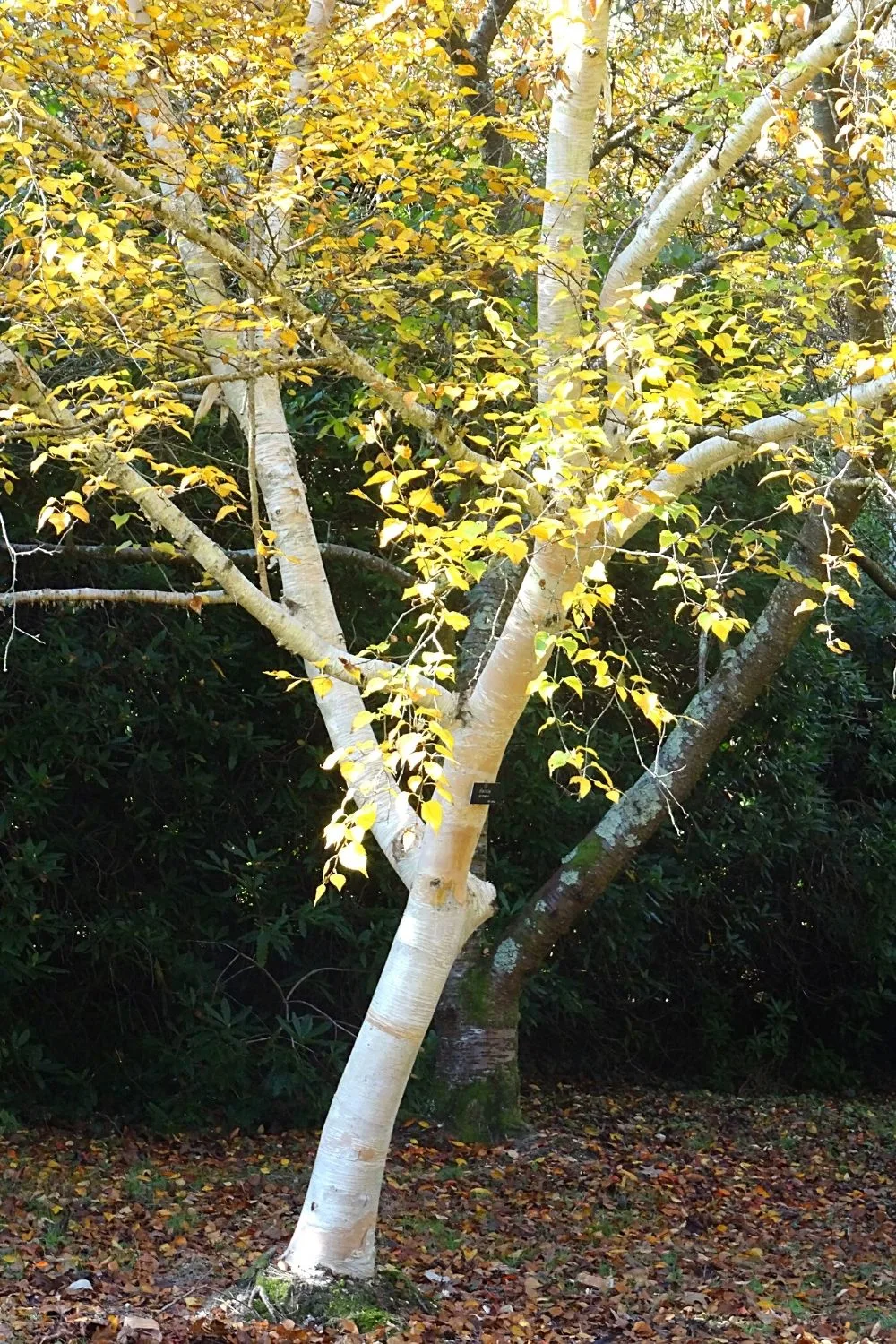
West Himalayan Birch is another stunning tree that you can plant in your southeast facing garden
West Himalayan Birch is a stunning tree that can be the perfect addition to any garden. You can grow your West Himalayan Birch as tiny trees as well.
West Himalayan Birch binomial nomenclature and basic plant care requirements include:
- Temperature: between 65 to 80 degrees Fahrenheit (18-to-27 degrees Celsius)
- Fertilizer: fertilize with a low-nitrogen fertilizer
- pH: 5.0 – 6.5
- Soil: likes loamy, moist, sandy clay, but well-drained clay
- Lighting: full sun to partial shade
- Growth rate: moderate to slow growth
- Humidity: no specific requirements
- Scientific name: Betula utilis
- Family: Betulaceae
Conclusion About Plants for Southeast-Facing Garden
Having a southeast-facing garden is definitely an advantage as you can grow some of the most vibrant and colorful plants under bright sunlight. Thus, if you too have a southeast-facing garden, I hope this extensive list helps you in finding the best plants for your southeast-facing garden.

Daniel has been a plant enthusiast for over 20 years. He owns hundreds of houseplants and prepares for the chili growing seasons yearly with great anticipation. His favorite plants are plant species in the Araceae family, such as Monstera, Philodendron, and Anthurium. He also loves gardening and is growing hot peppers, tomatoes, and many more vegetables.

![30 Plants for Southeast Facing Garden — Best Guide [2024]](https://plantophiles.com/wp-content/uploads/2022/04/30-Plants-for-Southeast-Facing-Garden-720x405.jpg.webp)
